 By Staff By Staff
March 20, 2014
BURLINGTON, ON.
St. Luke’s Church Annual Spaghetti Dinner!
 In the Parish Hall 1382 Ontario Street, on Saturday April 5 with continuous servings of the best spaghetti & meat balls in town from 5:00pm to 7:00pm. In the Parish Hall 1382 Ontario Street, on Saturday April 5 with continuous servings of the best spaghetti & meat balls in town from 5:00pm to 7:00pm.
Tickets Adults $10.00
Children 12 & under $5:00
They want you to reserve – call 905-634-4345.
Cash bar serving Wine, Beer & Soft Drinks – these ARE Anglicans!

 By Pepper Parr By Pepper Parr
March 17, 2014
BURLINGTON, ON.
When we first wrote about the Conservation Heritage District we said this was going to get messy. Once people read the document the city released for discussion at a committee not yet known on a date yet to be determined all hell is going to break loose.
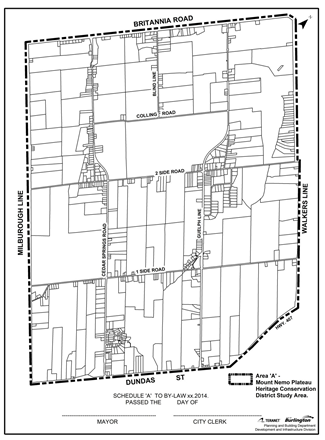 The area covers basically all of the western half of the Escarpment. There are provisions in parts of the draft by-law that will forbid just about everything during the first year of the bylaws existence. At the February meeting in Kilbride city planning director Bruce Krushelnicki told the audience that what was being proposed was a bylaw that the city could pass and revoke any time they wished. The audience wasn’t convinced however, but they did go along with taking a next step which was to do a study. It seemed like a good idea at the Kilbride meeting; nothing overly complicated.
The decision to take that next step was the result of a show of hands which that evening was overwhelmingly positive even though there were a number of people who didn’t like the idea of the city butting into local affairs.
Staff went away to prepare the report that was to set out what the next step study was going to be and what the public could expect to come out of it.
During a city council meeting on the budget when the city was approving the time needed for a planner to oversee much of this work and the expense involved, Jack Dennison, councillor for ward 4 made the point that “this wasn’t something we brought to Council” and indeed the idea of creating a Conservation Heritage District did not originally come from the city planners.
It was the result of an application a group of residents had made to the Niagara Escarpment Commission (NEC) to have as much of the Escarpment as possible protected under a some form of protection. PERL – Protect the Escarpment and Rural Lands made the application and met with the NEC planners and learned that they really weren’t going to be able to get what they wanted.
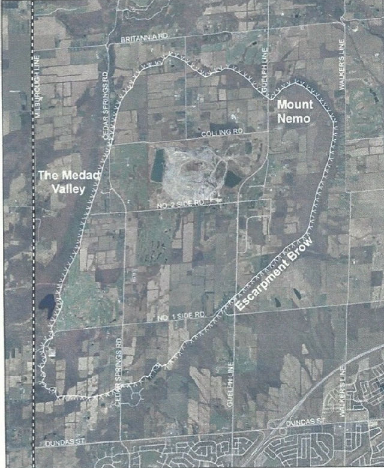 A topographical view of the study boundaries. The Niagara Escarpment Plan which comes from the Niagara Escarpment Commission formed in 1937, has three categories of protection: Nature Areas; Protection Areas and Rural Areas. Each of these apparently has a cultural aspect or element to them which is conveyed with wording such as: “encourage the conservation of traditional cultural landscapes” – which is probably what the Aboriginal people were trying to see when the white people moved in.
 PERL fought to prevent an expansion of the existing quarry. The lower orange outline was the area where the expansion was to take place. PERL was the citizens organization that won the fight against an expansion of the Nelson Quarry. While it was the city that put forward the lead lawyer and spent $2 million in legal fees on that battle, PERL was given standing at the Joint Tribunal and had a consistent impact on the direction that Tribunal went.
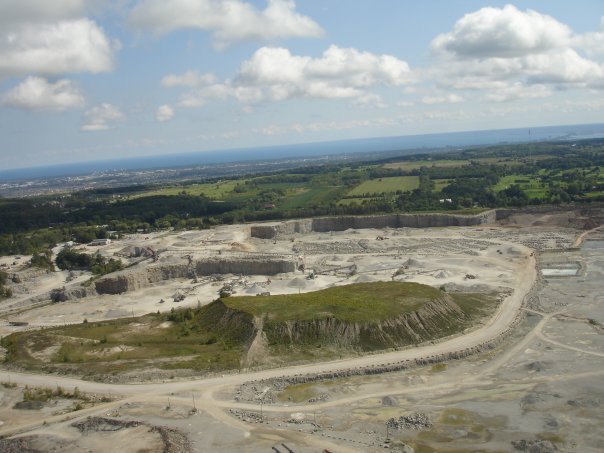 One of these was enough for the people in rural Burlington. Is a bylaw creating a Heritage Conservation District the best way to prevent any quarry application – or is there a larger objective being sought? PERL eventually pulled their application to the NEC for some form of protection for the Escarpment, particularly the Mt Nemo plateau and went to Councillor Taylor with what they felt was a better approach – do something via the Official Plan Review which was taking place.
They came up with the idea of asking if creating a Conservation Heritage District (CHD) could be part of the Official Plan review. While that review is ages from being complete and even longer from being approved – the planners seem to be moving along at what is breakneck speed in the planning world to get a bylaw in place that would make a large swath of rural Burlington a Heritage Conservation District and thereby protect the plateau.
PERL hasn’t said a word publicly. The last date of an entry on their website is November 2012. They have worked quietly with Councillor Taylor who clearly intends to make doing something substantial to protect the plateau his legacy issue; should he win the October election for his ward one would expect that to be his last term of office.
Once the public becomes fully aware of the planned bylaw there will be some “not so fast” comments as well as some OMB level mutterings. Paletta International complained in a letter to the city that they knew nothing of this initiative and asked that their lands be removed from the study area. It doesn’t quite work that way – everything gets studied or nothing gets studied.
The staff recommendation that will get to a Standing Committee at some point in the near future but perhaps as late as June, making it an election issue for some, came out of a process that started back in July of 2013. At the July 2, 2013 city council meeting Councillors Craven and Taylor brought an amendment to whatever was discussed in the CLOSED session part of the June 18th meeting.
Fast forward to what is going to go to a city Standing Committee at a yet unknown date this. Staff is asking that council:
ENDORSE the Terms of Reference for the Heritage Conservation District Study and Plan for the Mount Nemo Plateau, dated March 7, 2014; PROVIDE the Manager of Procurement Services delegated authority to award the contract(s) and issue a Purchase Order to the highest scoring Proponent(s), subject to budget limitations of $200,000; AUTHORIZE staff to commence a Heritage Conservation District Study process for the Mount Nemo Plateau; DIRECT staff to report back following the completion of the Heritage Conservation District Study process prior to the commencement of a Heritage Conservation District Plan process in accordance with s. 40 of the Ontario Heritage Act;
APPROVE an upset limit of $200,000 for the Heritage Conservation District Study and Plan to be funded from the Tax Stabilization Reserve Fund; APPROVE the Mount Nemo Plateau Study By-law, which is set out in an Appendix to the staff report.
Staff wants the city to RECEIVE the draft Study Area Control By-law which may be passed in the event that a potential threat arises to the integrity or character of the study area.
Added in is a requirement that staff report back to council on the views of the public in Q2 2014 – that’s before the end of June. Given the winter we have had all the frost might not be out of the ground by then. And we will be four months away for an election which will likely turn this issue into an election question. What’s the rush?
Ward 3 councilor John Taylor said on Saturday that he intends to campaign on this issue. To Taylor’s credit he has been very diligent in working for the interests of the people north of 407 and while he lives south of Upper Middle Road much of his heart is in the rural part of Burlington.
There is more to this development which we will follow up on. The terms of reference need a look, the cost – they are talking in terms of $200,000 and the level of public participation in this initiative are all critical.
Background links:
Newsflash on the CHD meeting in Kilbride February 10th

 By Pepper Parr By Pepper Parr
March 17, 2014
BURLINGTON, ON.
Information is power. Knowing what is happening gives the person with the information an advantage over the person who doesn’t have that information.
City hall has tons of information – getting at it is not always easy.
 The city recently released a report, it was put together by Andrea Holland of the Clerks department and covers almost every sin imaginable when it comes to what information there is, what you can have, what you can’t have and how you get it. It’s not exactly an easy read but the information is there. The city recently released a report, it was put together by Andrea Holland of the Clerks department and covers almost every sin imaginable when it comes to what information there is, what you can have, what you can’t have and how you get it. It’s not exactly an easy read but the information is there.
Transparency, accountability and privacy are common themes today. The City of Burlington is committed to fostering a culture of transparency, based on the principle that city information:
Must be provided to the public, limited by a few exceptions
Should be released proactively and responsibly.
Early in this decade the provincial government created the Freedom of Information and Protection of Privacy Act; FIPPA for short. The purposes of this Act are,
(a) to provide a right of access to information under the control of institutions in accordance with the principles that,
(i) information should be available to the public,
(ii) necessary exemptions from the right of access should be limited and specific, and
(iii) decisions on the disclosure of government information should be reviewed independently of government; and
(b) to protect the privacy of individuals with respect to personal information about themselves held by institutions and to provide individuals with a right of access to that information.
The province then created a sub set for the municipal sector and called that MFIPPA. In order to provide clarity around the FIPPA legislation with regards to records of members of council and the protection of personal information contained within those records, staff have prepared a reference guide – Access, Privacy and Records, A Guide for Council. It is to provide you with information to make informed decisions about the personal information you have within your office.
 The guide was prepared in consultation with staff and members of council to ensure that the information provided was clear and informative. Further research was conducted on Information and Privacy Commission orders that have been issued with respect to councilor records as well discussions with staff from the Ministry of Government Services. The guide was prepared in consultation with staff and members of council to ensure that the information provided was clear and informative. Further research was conducted on Information and Privacy Commission orders that have been issued with respect to councilor records as well discussions with staff from the Ministry of Government Services.
The Municipal Freedom of Information and Protection of Privacy Act (MFIPPA) came in to effect on January 1, 1991. It applies to all municipalities in Ontario, including local agencies, boards and commissions, school boards and police services.
MFIPPA has two purposes:
Allows every person to request information from a municipality
Describes how the municipality must respond to requests, step by step
Lists limited and specific situations where access must not or may not be granted
Allows individuals to access and correct their own personal information
Requires that municipalities protect personal information in their care
Establishes rules for how personal information must be managed, including proper collection, use and disclosure
Compliance with MFIPPA is overseen by the Office of the Information and Privacy Commissioner of Ontario (IPC). If a requester is not satisfied with the quantity or quality of information released by a municipality in an access to information decision (e.g. adequacy of a record search, information withheld under an exemption), or if an individual feels that their privacy has been breached while interacting with a
municipality, appeals and complaints may be made to the commissioner. Following an investigation, the IPC will then issue a public order or report describing the circumstances of an appeal or complaint, and what must be done to resolve the matter.
Transparency, accountability and privacy are common themes today. The City of Burlington is committed to fostering a culture of transparency, based on the principle that city information:
Must be provided to the public, limited by a few exceptions
Should be released proactively and responsibly.
This report explains how MFIPPA applies to elected officials at the City of Burlington, and provides guidance for how to comply with the Act in daily practice.
MFIPPA and the City of Burlington:
The City Clerk has been delegated with the responsibility for overseeing and administering MFIPPA within the municipality. Within the Clerks Department, the Records and Information Coordinator is responsible for the receipt and processing of access requests, providing advice and consultation to corporate staff, serving members of the public, and advocating for privacy and confidentiality throughout the organization.
FOI request process:
1. A request is received via mail, or in person at the Service Burlington counter. Requests must be accompanied by a legislated $5 fee.
2. The records and information coordinator sends a search memo to all affected departments and staff, which may include individual members of council.
3. Within 7 days, the affected departments and/or individuals provide unaltered and entire records to the records and information coordinator, along with recommendations on release, for analysis.
4. The records and information coordinator analyzes each record to determine whether or not it should be released under MFIPPA. At this stage, the Clerk’s department may seek an opinion from the City’s legal counsel.
5. When analysis is complete, a release package is prepared and approved by the City Clerk. Records may be released in part or in full, or withheld in their entirety, in situations where all responsive records are exempt from disclosure, or where no records exist.
6. All records pertaining to the request are securely stored in a locked cabinet in the Clerks Department until the required retention period has expired.
What is a record:
MFIPPA defines ‘record’ as “any record of information however recorded, whether in printed form, on film, by electronic means or otherwise.” The definition is broad in order to include the full range of possible information formats.
Under MFIPPA, councillors are not considered to be officers or employees of the corporation and records related to interactions with their constituents as elected officials (constituency records) are therefore not covered by MFIPPA and therefore not accessible under the Act. However, if a member of council holds corporate records  created by the City of Burlington, or is discussing city business, or where they relate to city business such as communicating directly with City staff, that information may be accessible under MFIPPA. created by the City of Burlington, or is discussing city business, or where they relate to city business such as communicating directly with City staff, that information may be accessible under MFIPPA.
Councillor Assistants are considered to be City of Burlington employees, to which MFIPPA access provisions do apply.
 Constituency records: Constituency records:
Records of a councillor acting on behalf of a constituent and representing their interests are not accessible under MFIPPA. This includes all content, opinions and personal information contained in any correspondence to and from a constituent, i.e. name, phone number, email and mailing address. For more details on what constitutes personal information, see Definitions below.
Examples:
Correspondence from a constituent concerning a pothole in their neighbourhood
Email from a constituent requesting that the councillor attend a community event
Correspondence between a councillor and a private sector company
City business records:
Corporate records include information that is related to the business of the city, its agencies and boards, and may be requested through MFIPPA. All corporate records related to city business are also governed by the City of Burlington records retention by law 97-2005 and amending by-law 62-2013.
Examples:
Email sent to city staff and members of council, including carbon copies (cc).
Councillor records that advance the interests of the city.
Councillor forwards request for pothole repair to Roads and Parks Maintenance.
Roads and Parks Maintenance receives a request sent via email directly from a constituent to repair a city owned asset.
Email from a citizen, forwarded to a city department by a Councillor’s Assistant for follow up
Records related to a Council member’s involvement with a City agency, when acting on behalf of the city.
 Email: Email:
Email between Council members and city staff is typically accessible under MFIPPA. Other email contents which are not generally accessible under MFIPPA include:
Citizen contact lists, addresses and phone numbers stored in email systems (hosted and on site, i.e. Outlook; Constant Contact.)
Emails between a member of council and a constituent or local business
Personal emails sent from one member of Council to another.
When a FOI request is received for councillor records, all requests will be analyzed on their own merit and a decision will be made whether the records are subject to MFIPPA or not, and if they are, a further decision will be made to release or withhold. Each request represents a unique set of circumstances that will need to be considered.
Councillor records management: During the term of office and when re-elected.
At the start of each term of office, members of Council will receive training on MFIPPA as part of Council orientation.
Corporate records related to city business must be retained and disposed of according to the City of Burlington records retention by-law.
Confidential and Transitory information, including draft or working documents and duplicate copies, can be securely destroyed in a locked shredding bin or with a cross-cut shredder when no longer required. On-site shredding services are highly recommended for secure disposal of personal, confidential and sensitive information.
Constituent records fall under the sole custody and control of the member of council. Even though MFIPPA does not apply to these records, each councillor should take steps to safeguard any personal information that is in their possession from unintended use or disclosure.
Constituent records can be treated as “General Correspondence” for retention purposes, with a suggested retention period of Current + 4 years.
 Any constituent records and/or personal information that has been collected by a member of Council or received through the Councillor’s office, including contact details, that resides on city email or other city-owned resources, can not be shared or used for any purpose without the individual’s prior consent. Similarly, contact information cannot be shared with election teams without prior consent to do so from the individual. The voter’s list is not intended for use related to constituency business. Any constituent records and/or personal information that has been collected by a member of Council or received through the Councillor’s office, including contact details, that resides on city email or other city-owned resources, can not be shared or used for any purpose without the individual’s prior consent. Similarly, contact information cannot be shared with election teams without prior consent to do so from the individual. The voter’s list is not intended for use related to constituency business.

Before leaving office, a councillor may forward any outstanding constituency matters or ward-related documents to their assistant for future follow up with a request to the affected constituent for approval to send the unresolved matter to the incoming councillor.
Private or personal contacts saved in Outlook folders must be destroyed.
 If an elected official wishes to retain a copy of any records associated with their time in office, contact the City Clerk. If an elected official wishes to retain a copy of any records associated with their time in office, contact the City Clerk.
Any records and documents retained by former councillors must be kept according to the City of Burlington records retention by-law. Electronic records should be encrypted, using one of several methods available.
When there is a change in office, the Councillor’s assistant should send an email to all current recipients of the Ward newsletter, offering a clear option to opt in and continue receiving the newsletter, or to opt out from future communication.
One example is provided below:
“As you may be aware, a new Councillor will be in place for Ward X as of December 1. If you wish to continue receiving the Ward X newsletter, please opt in at the link below.”
Collection, use and disclosure under MFIPPA
MFIPPA includes specific requirements for how municipalities collect, use and disclose personal information.
Every time that personal information is collected by a municipality, notice must be provided to the affected individual(s) which states:
The legal authority to collect
The purpose(s) for which the personal information will be used
The title, business address and telephone contact for an officer or employee who can answer questions about them collection.
MFIPPA prohibits the collection of personal information unless the collection is:
Expressly authorized by law, or
Used for the purposes of law enforcement, or
Necessary to the administration of a lawfully authorized activity.
 The personal information collected by an institution may only be used under the following conditions: The personal information collected by an institution may only be used under the following conditions:
With informed consent from the individual
For the purpose for which it was obtained or compiled, or for a consistent purpose.
A municipality is not permitted to disclose personal information in its custody or under its control, unless the person to whom the information relates has consented to its disclosure, or in a few other limited circumstances described under the Act, for example: when there is statutory authority to disclose for law enforcement purposes.
Example:
The name and address of a citizen signing in at a public meeting can only be disclosed if the citizen provided consent,or if the possibility of disclosure was indicated in a written collection notice posted at the meeting.
The use and disclosure of personal information must always be consistent with the original purpose for which it was collected.
A consistent purpose is defined under MFIPPA as something an individual might reasonably have expected. Reasonable expectations are typically established in collection notices.
Under MFIPPA, councillors do not have any special right of access to records held by municipalities, including the personal information of citizens and employees.
In other words, members of council may only access information that would not normally be exempt from disclosure under MFIPPA. The same is true for former members of council or employees who, at one time, may have had access to records in the performance of their duties.
This approach is intended to protect members of council and the City of Burlington from the following risks:
 Contravening MFIPPA Contravening MFIPPA
Breach of privacy or confidentiality
Negative media exposure Example:
Members of Council cannot access contact information listed on public meeting sign-in sheets unless the attendee has consented to that kind of disclosure in advance.7
Records of unsuccessful tender submissions for a city construction project are reviewed and redacted according to MFIPPA exemptions before being received by a member of council, if requested outside of standing committee and council documentation
Councillors may have a right of access to certain types of information that would not be available to the general public, if they require the information in their capacities as members of council in order to carry out duties related to that function.
Councillors who wish to request information from the City of Burlington outside of their official capacity may submit an FOI request to the Clerk’s department at any time.
Access to personal information:
Where a councillor acting in their official capacity seeks access to personal information held by the city (for example, the personal information of an employee), information may only be obtained if the individual has provided prior consent.
The Mayor, as Head of Council, is considered an “officer” of the City. The Mayor’s records that relate to the mayoral duties, as opposed to constituency or personal papers, are considered to be in the City’s custody or control and therefore may be requested under MFIPPA.
 Examples of mayoral duty records, which may be accessible: Examples of mayoral duty records, which may be accessible:
Notes taken at Burlington Hydro meeting, while acting in official capacity
Speech delivered at opening of new recreational facility
Staff within the Office of the Mayor are considered to be in political positions, to which MFIPPA access provisions do not normally apply. For example, an email sent from the Mayor to one of their staff members would not typically be accessible under MFIPPA. However, if city staff are copied on the email, it could be accessible.
Any time that the Mayor or one of his or her staff forwards a customer service or constituency matter to city staff for follow up, that record may also be requested under MFIPPA.
This is in contrast to staff working within Councillor offices, who are considered to be City of Burlington employees to which MFIPPA access provisions do apply.
Definition of personal information:
“personal information” means recorded information about an identifiable individual, including,
(a) information relating to the race, national or ethnic origin, colour, religion, age, sex, sexual orientation or marital or family status of the individual,
(b) information relating to the education or the medical, psychiatric, psychological, criminal or employment history of the individual or information relating to financial transactions in which the individual has been involved,
(c) any identifying number, symbol or other particular assigned to the individual,
(d) the address, telephone number, fingerprints or blood type of the individual,
(e) the personal opinions or views of the individual except if they relate to another individual,
(f) correspondence sent to an institution by the individual that is implicitly or explicitly of a private or confidential nature, and replies to that correspondence that would reveal the contents of the original correspondence,
(g) the views or opinions of another individual about the individual, and
(h) the individual’s name if it appears with other personal information relating to the individual or where the disclosure of the name would reveal other personal information about the individual.
There you have it. Not the kind of document you will take to the beach to read in the summer – but it is the kind of document you might want to refer to – and it will be on the Gazette website for a long time – until it is revised.
In the past these rules have not been fully observed. with an informed public – we just might see better compliance.

 By Staff By Staff
March 19, 2014
BURLINGTON, ON.
In a recent letter sent to the Friends of Freeman Board of Directors, David explains his reasons for painting “The Burlington Freeman Station”. David’s letter is reproduced below.
“ Over the past 35 years of my art career I have been striving to accomplish one thing, and that is to preserve Canada’s Heritage through my art. This has led me to create paintings of famous Canadian Heritage scenes, buildings, tall ships, covered bridges, lighthouses and more recently a series of Historic Canadian railway stations.
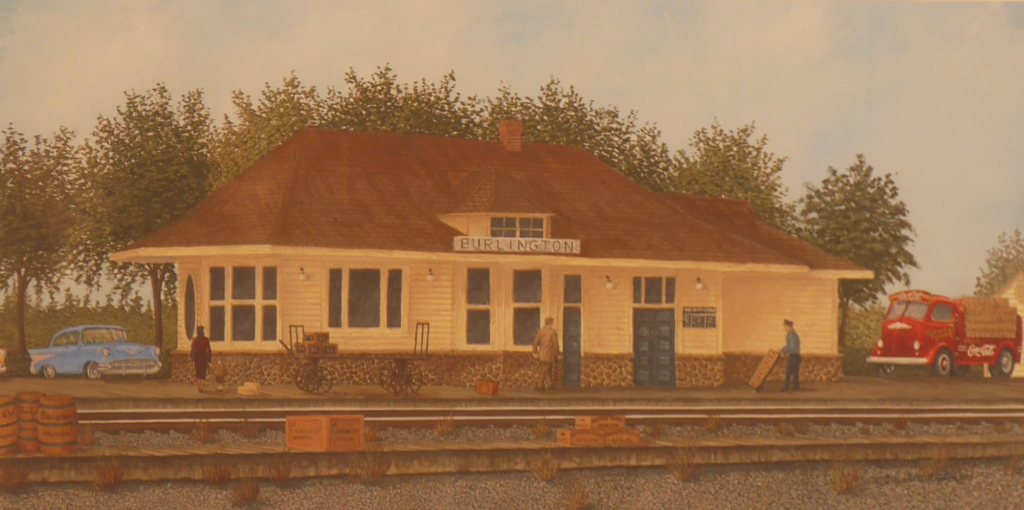 David Harrington’s limited edition print of the Freeman Station is available for purchase – but just to Friends of Freeman Station members. The membership is a steal at $10 annually. In 2012, when I read an article in the Burlington Post about a citizen’s group, named the “Friends of Freeman Station”, attempting to rescue and preserve Burlington’s Freeman Station, I decided that the Freeman Station was definitely worthy of creating a painting that I hoped would capture some of the historical flavour of its famous past. For reference purposes I took over 100 photos of the station when it was temporarily located behind the Burlington fire hall on Fairview Street. I also researched to find historical photos and stories related to its past. In addition, I managed to talk to some people who recall using the Freeman Station. From all of this information, I decided to portray the station as it stood in the late 1950’s to early 1960’s.
 To position it to that era, I included a 1957 Chevrolet Bel Air (a favourite to this day amongst car enthusiasts), and a 1955 era “White Diesel” Coca Cola truck. The Coke truck was added to capture the story of one of the people who used the station frequently, who told me that he usually bought a Coke from the vending machine inside the station prior to the train arriving to take him to Toronto. If you look real close you can also see just a portion of a 1956 Ford Crown Victoria peeking out of the left side of the image. To position it to that era, I included a 1957 Chevrolet Bel Air (a favourite to this day amongst car enthusiasts), and a 1955 era “White Diesel” Coca Cola truck. The Coke truck was added to capture the story of one of the people who used the station frequently, who told me that he usually bought a Coke from the vending machine inside the station prior to the train arriving to take him to Toronto. If you look real close you can also see just a portion of a 1956 Ford Crown Victoria peeking out of the left side of the image.
At that time, for many companies, the train was the main method used for shipping their products. For this reason I thought that I should include, on the railway platform, wooden shipping containers originating from famous Canadian companies of that era. You will note wooden crates from The T. Eaton Company, Barber Glass of Guelph, Seagram’s of Montreal, G & W of Toronto and Corby’s of Corbyville, Ontario.
I also added the luggage cart from the same era, as well as a mother and child with her 1950’s style luggage, also a business man heading into the station and of course the Coke delivery man. All of which I hoped would add to the sense of history and the hustle/bustle nature of the station in its prime.
I hope that this painting and the limited edition prints produced from this image help in keeping the memories and history of Burlington’s Freeman Station alive and that it may also bring back memories to those who had the good fortune of using this station in the past.
There are not many of these great stations left – so let’s all work together to help preserve Burlington’s Freeman Station!!”
David Harrington
The Harrington painting is an original done as an acrylic from which a limited edition of 500 prints were made.
While the station is fondly known as the Freeman Station and the organization that was incorporated to save it is known as the Friends of the Freeman Station there appears to be a move to revert to the proper name of the station which is Burlington Junction. We are told that the Freeman family isn’t all that keen on the idea of their name being attached to the station.
The T-shirts that were used for fund raising purposes are going to soon become collectors items – the couple of dozen left are the end of that production line. The FoF are in the process of developing ideas for a new logo, a new design and it appears a re-branding of one of the most impressive community initiatives Burlington has seen for some time.
The FoF might want to re-think what they are deciding to do and ask their constituency how they feel. Either way – it’s a pretty good story.
Background links:
New president at Friends of Freeman.
Fight to save Freeman station is won – city signs joint venture agreement.

 By Pepper Parr By Pepper Parr
March 15, 2014
BURLINGTON, ON.
John Willard has certainly put a much different twist on what we thought quilts were all about. Canadians used to see quilts as things that people on farms used – often made out of bits and pieces of discarded clothing and flour sacks.
We then saw quilts done by the Mennonite community that were pieces of art – with traditional patterns that sold into the tens of thousands at the annual quilt sale in New Hamburg each fall.
 A lot of tradition in this quilt but the use of pastel colours move it out of what many see as the “traditional” rural quilt made from remnants and flour sacks. Then along came John Willard who introduced designs that had not been seen before and quilt making was now going in a different direction. Willard has a 40 year retrospective on at the Burlington Art Centre where there is a feast for the eye and, if you look very closely, some very, very powerful statements hand stitched into a quilt.
There are a number of quilts that would meet the demanding standards of the Mennonite community and there is one that would fill the wall of one of those Lakeshore mansions.
Willard will tell you the very moment he became an artist. The family came across an old trunk stuck in a chicken coop on a family farm in Shediac, New Brunswick. It was filled with brightly coloured crepe paper – that moment James Willard could almost feel the colour entering his blood stream – we see that colour today on the walls at the Burlington Art Centre.
Willard was a set designer, a photographer He bought his first quilt in 1972; in the next five years he could display a collection of 30 quilts.
His work has meandered all over the place. He worked as a custodian at the Oakville Library and later accepted the position of Publicity and Programming Assistant which he held for 23 years.
Willard’s introduction to the finer art of actually quilting was received at the hand of Michael James who was giving workshops. Willard didn’t subscribe to the diehard traditionalists who insist quilts must be completely hand stitched from geometric blocks, have four square corners and be used as bed covering upon completion. Willard went with those who believed a quilt could be of any size, shape, texture or subject matter and could be hung on a wall to be admired as a work of art.
 It all began on an evening in 1907 needs very close inspection. What appears to be white caps on the waves is much more than the eyes sees at first glance.
There is a quilt that didn’t do much for me when I glanced at it. It saw it as a postcard, mildly interesting, until a woman asked if I’d looked at the Titanic – I said I had but it wasn’t my kind of quilt – but that I did like the ribbon quilts. “Take a closer look” the woman said to me. I did and said – “so it’s a quilt of the Titanic sinking – there are two of them.”
 The names of those lost when the Titanic sank in 1907 With that tone of voice only a teacher or a Mother can use, the woman said: “get closer” so I walked up and took a really close look – and then it hit me. The names of the more than 1500 people whose lives were lost when the Titanic sank at sea were hand stitched into the waves the ship was sliding beneath. The quilt is called: It all began on an evening in 1907.
 This massive piece needs a very large wall – it takes over any room it is installed in – but then what a room. The colour, the energy – it is almost a tapestry. The Ribbon Series, of which here are seven at the exhibit, celebrate a turning point in Willard’s life when he came out of the closet and embraced his life as a gay man with a joy and celebration that is evident in the flows of the ribbons in some of the quilts and the tight design and discipline in others.
 The colour, the flourish and the tight discipline take the art of quilt making some distance from the remnant quilts traditionally seen as folk art. Willard is very much a quilter, evident when you watch the way he holds the needle and draws a thread tightly but he has always relied on fellow quilters who have worked with him following his designs and instructions. The late Alvina Martin and Linda Robertson have done much of the finishing work from designs Willard spent months perfecting.
This is an exhibit well worth the time. It is the work of a master who broke old moulds and advanced the art of quilt making to a new level.
The quilts are on display until the end of the month – well worth some of your time.

 By Pepper Parr By Pepper Parr
March 15, 2014
BURLINGTON, ON.
Much like the way rolling stock went through town at the Burlington Junction, what we fondly call Freeman Station, people come and go at the organization that is getting ready to begin real work on the structure that now sits on the north side of Fairview just before you get to the fire station.
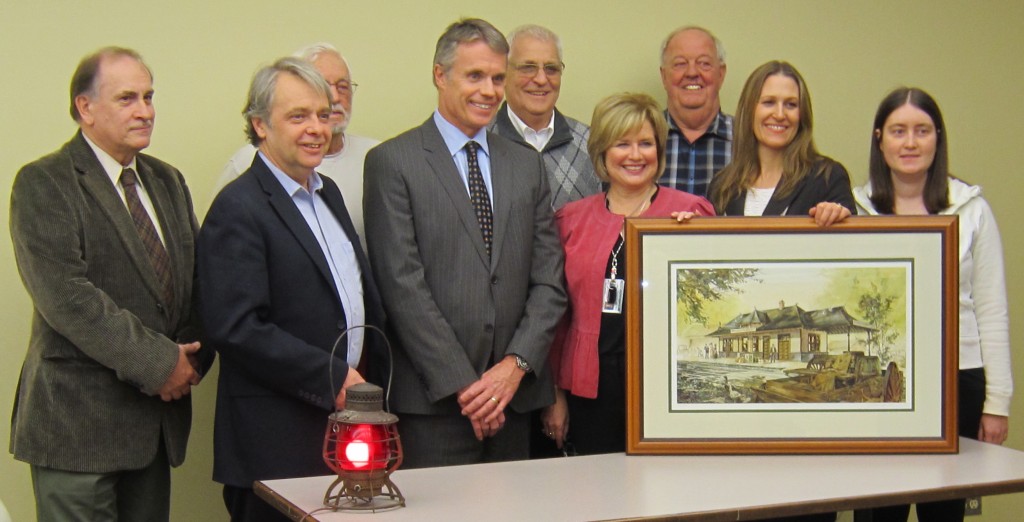 It was a proud day for James Smith – the signing of the Joint Venture Agreement between the city and the Friends of Freeman Station. Smith, standing behind the red light, signed on behalf of the organization. The Board of Directors announced that James Smith, President of Friends of Freeman Station (FoF) has resigned for personal reasons – good personal reasons. Smith will remain on the Board of Directors. He was a lead player in the significant effort that saved the station from the wrecking ball – the city did everything it could to get rid of the building – weren’t even able to sell it for scrap wood.
Brian Aasgaard, will assume the position of President; he served as a Vice-President of Friends of Freeman Station for a number of years. Brian has done an outstanding job as Vice-President, and will devote the same level of high energy and enthusiasm he has always shown. Brian has this uncanny knack for getting people to give the FoF stuff that relates to railway operations.
The FoF is always looking for new members, especially people who are good with tools and want a reason to get out of the house and be with the guys.
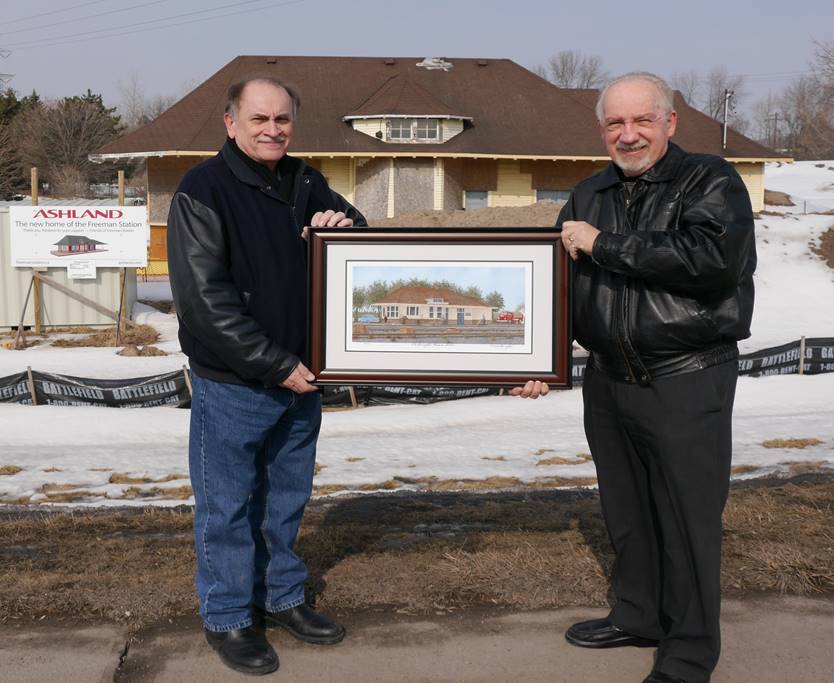 John Mellow stands in the cold with artist David Harrington proudly displaying a print of the building the FoF are refurbishing to its 1906 condition. The renowned, internationally acclaimed heritage artist, David Harrington has taken out a membership and generously donated one of his limited edition prints to Friends of Freeman Station to assist in their fundraising efforts to restore the station back to its 1906 when it was first constructed. This limited edition “ The Burlington Freeman Station” print is numbered 19/500, signed by the artist.
Getting the public to take a sense of ownership in a project is a fine art – coming up with a name that tells the story in a few words is part art and part science. The good people over at the Friends of Freeman Station appear to be breaking one of the cardinal rules in keeping a story alive and growing: never mix up the message.
 Most people know it as the Freeman Station – even though officially it was the Burlington Junction station and that is what the sign on the structure will say the day it is opened as a tourist destination. We are seeing the words Burlington Junction being used – and that is in fact the real name of the station. It was one of two train stops in Burlington. The Burlington West station was the one used by the farmers to ship their produce into Toronto. It was located near a farm owned by the Freeman family and came to be known as the Freeman station when in fact the Freeman’s and had nothing to do with the station. Farmers tend to talk in terms of property by the name of the people who own the land – even though the ownership of that land changed hands years ago.
However, the public knows it as the Freeman Station – introducing the real name in media releases just confuses people. Do what the politicians do – stick to the message. If you don’t – you lose your audience.
Background links:
Freeman station saved – city signs the agreement.

 By Staff By Staff
March 14, 2014
BURLINGTON, ON
I didn’t know we had that many Irish people in the city. This year’s well-celebrated St. Patrick’s Day falls on Monday, March 17th and the Halton Regional Police Service officers will be out on Monday ensuring those that clink glasses won’t clink cars.
Blatantly discrimination if you ask me. Were the police out in force on the feast of St. George? Certainly not – but then the British were never known for their boisterousness. A polite hear, hear is the best you can expect from them.
The police have recognized that many Halton residents will celebrate St. Patrick’s Day this Friday or Saturday night instead and want to advise motorists to expect to see several RIDE programs in effect and also note a higher uniform presence patrolling in licensed establishments over this weekend, educating the public about impaired driving and enforcing the laws to ensure everyone on our roads are safe.
On Saturday March 15th, the Halton Regional Police Service in joint partnership with the Ontario Provincial Police (OPP) , the Alcohol and Gaming Commission of Ontario (AGCO) and Mothers against Drunk Driving (MADD) will also be on location, conducting proactive checks at local LCBO and Beer stores throughout the Region.
 You will need the “luck of the Irish” to avoid the police dragnet this weekend. This team will be also be focusing their efforts on conducting bar checks at licensed establishments and reminding the staff of their responsibilities under the Liquor License Act, and encouraging staff to call police should they suspect a patron is about to drive a motor vehicle while impaired.
Informative St. Patrick’s Day fliers will be handed out at RIDE checks across the Region in efforts to educate the public and spread the word about the consequences of impaired driving.
The Halton Regional Police Service wishes everyone a Happy St. Patrick’s Day and encourages party-goers to celebrate responsibly. Don’t Press Your Luck!….Use a Designated Driver!
Would getting Leprephaun to take the wheel be acceptable?

 By Staff By Staff
March 13, 2014
BURLINGTON, ON.
If the inaugural meeting is any indication of what’s to come from this grassroots group, several local charities and organizations will be benefiting from additional funding, simply because passionate and caring women are coming together as 100 Women Who Care Burlington.
The concept is simple enough – 100 women (or more), $100 each (or more if you choose), 1 hour meetings 4 times per year. The goal is for 100 Women Who Care Burlington to collectively generate a minimum of $40,000 annually for local charitable initiatives. The impact is very powerful!
 Laurel Hubber, the energy behind this project said: “Just thinking about the impact we’ll have on much-needed charitable programs and services in our community is incredibly inspiring.” Laurel Hubber, the energy behind this project said: “Just thinking about the impact we’ll have on much-needed charitable programs and services in our community is incredibly inspiring.”
She put the word out to her friends and networking circle and asked if they would give an hour of their time to talk about people and organizations in Burlington that needed some help. Once they had decided who – the cheques got written and the funds distributed – all within an hour.
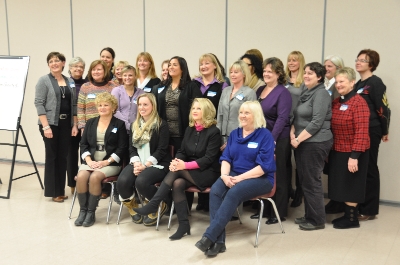 Having decided who they want to donate their funds to this first meeting of the 100 who care sat to have their picture taken. As a concept – this is very powerful. At their first meeting they chose the Burlington Humane Society as the recipient. Here is how Adrienne Gosse, Shelter Manager commented “the Burlington Humane Society was incredibly surprised to learn we were the recipients of this wonderful donation! You could hear the shouts of excitement and joy from the shelter staff and volunteers when we got the call from the 100 Women who Care foundation. This money will be used to provide our cats and dogs with all the medical care they need, such as medical exams by a veterinarian, vaccines, medications, spays and neuters, along with any additional care such as dentals and broken bone repairs.”
The group meets again on March 26, at Tansley Woods – for an hour, to donate and decide where the funds are to go this time. Meeting begins at 7:30 – ends at 8:30; registration takes place at 7:00 pm
Background links:
They get it done in an hour.

 By Pepper Parr By Pepper Parr
March 12, 2014
BURLINGTON, ON.
Last year it was one of those quiet hits – those who knew about it were amazed and those who didn’t get to the event said they wished they’d known.
It was called No Vacancy and took place at the Waterfront Hotel – the event lasted less than four hours and had hotel management skittish – it wasn’t quite the kind of thing Burlington had seen before.
It took place at a time when the city was getting a sense as to just what it was in terms of its cultural depth. It was edgy.
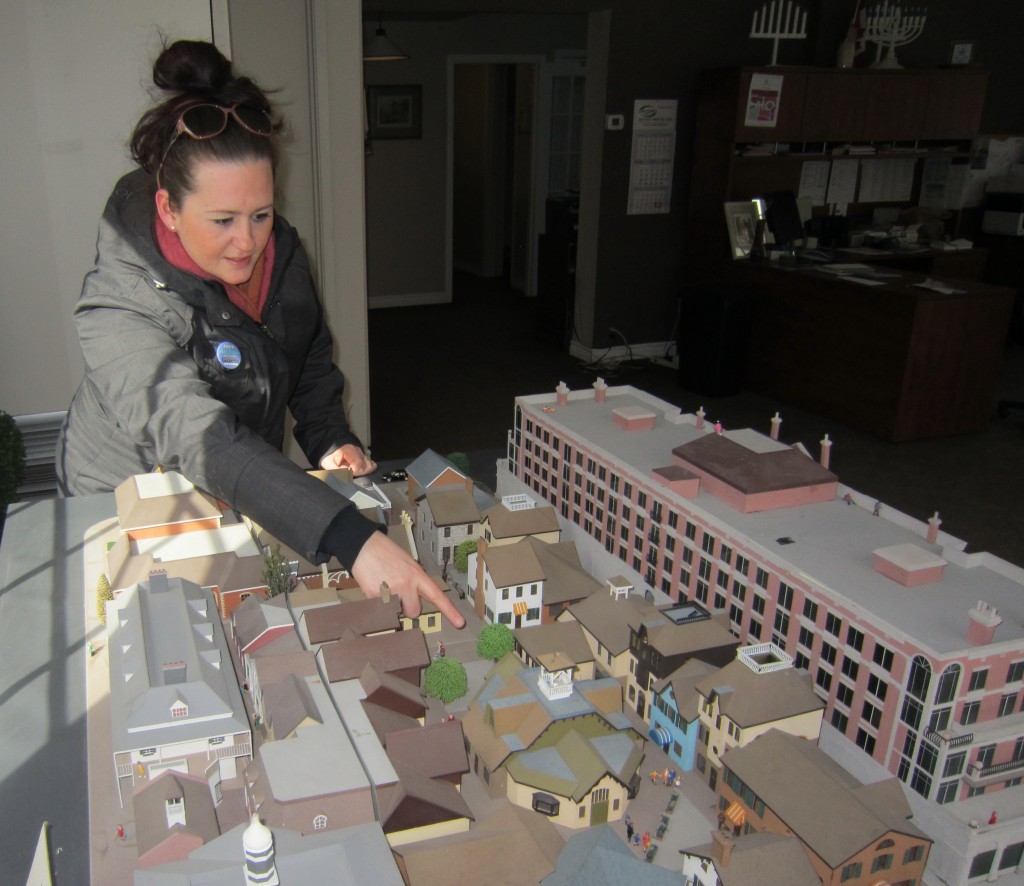 Selina Jane Eckersall points to one of the locations for some of the “installation art” that will be on display for seven hours September 19 – a not to be missed event. The best way to describe what Selina McCall Eckersall called No Vacancy is to say “installation art” and if that doesn’t mean all that much to you – think in terms of giving an artist a room or a space and telling them they can do whatever they want, make whatever artistic statement they want – just don’t put any holes in the walls.
With a small but very successful first step behind her Eckersall decided to up her game and go for a bigger venue. Date will be the same – September 19th – the location will be different and perhaps a surprise to many. Oh – and there is a name change as well.
 Newly named and branded as the Cirque, Eckersall wants the event to be Burlington’s Nuit Blanche. A Call for Entries that will go out this week. There will be 30 installations in various spaces at the Village Square which Eckersall hopes will bring new life to a location that was once the artistic hub of the city. Newly named and branded as the Cirque, Eckersall wants the event to be Burlington’s Nuit Blanche. A Call for Entries that will go out this week. There will be 30 installations in various spaces at the Village Square which Eckersall hopes will bring new life to a location that was once the artistic hub of the city.
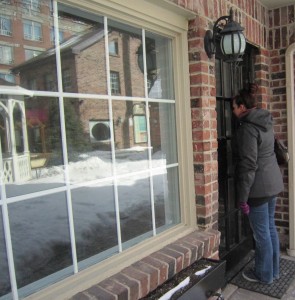 Eckersall peeks into one of the locations she expects to use for the Cirque “installation art” event next September The Square has languished for a number of years; it was put up for sale and then taken off the market. Eckersall will be working closely with Jack Friedman’s daughter Debra who recently closed the Artists Walk operation she ran for years.
Eckersall sees the Village Square as the local for the Cirque for at least five years – “After that” she said, “I’ve no idea where this project will go.” Eckersall added that the Art Centre has decided they want to use one of the 30 spaces for an “illustration” they want to create.
Eckersall is now in the process of raising the $50,000 it is going to take to get the event off the ground.
“We expect to have all the submissions in by around the middle of April and then we will see what we have in the way of concepts and begin developing sponsorships around them.” The Son of the Peach, an upscale pizzeria that will open soon, is sponsoring one of the instalations. This new restaurant will be right beside Pine, next to the Paradiso at the south end of the Village Square.
A Facebook page has been set – the Call for Entries will be at that location.
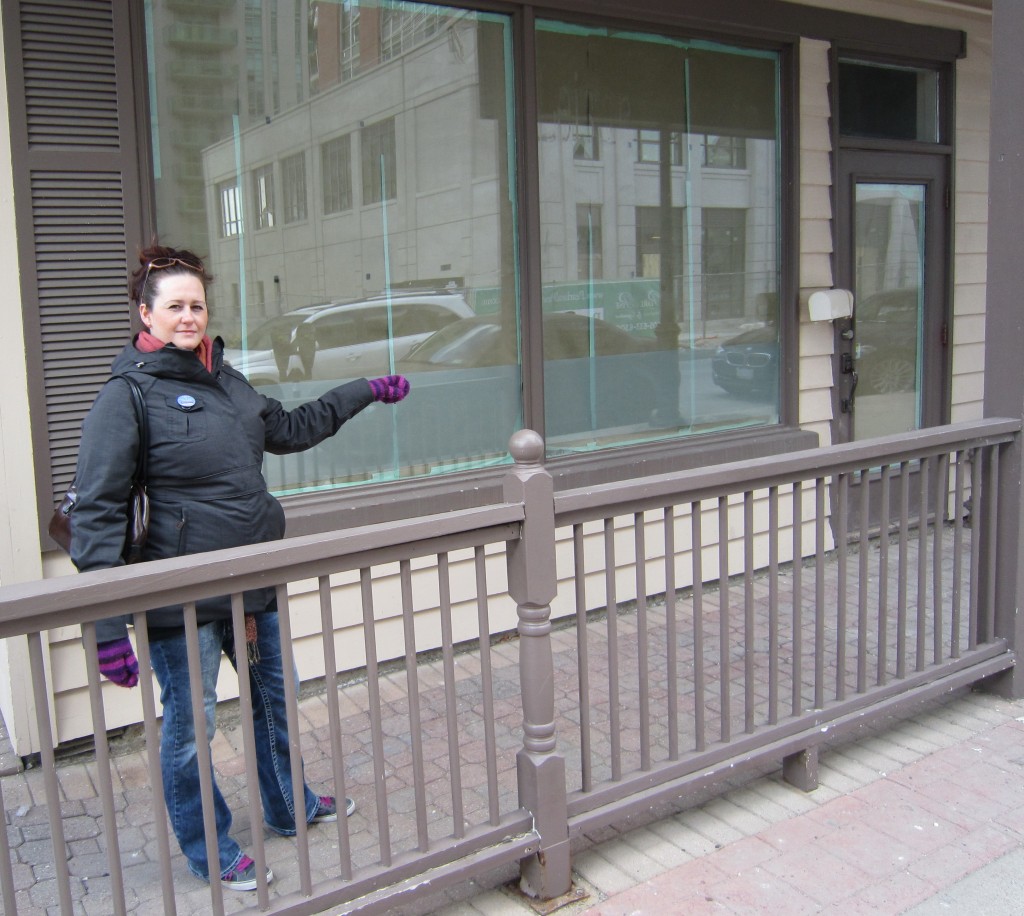 Home for a new upscale pizzeria – The Son of a Peach, the location will also host one of the installation art events next September. Some of the sponsorships will come from the existing Village Square tenants said Eckersall who needs to determine just what they are comfortable with. Several of the “installations” at the waterfront were very avant-garde, almost aggressively so, which is what gave the event last year that wonderful edge it had.
The event will begin at 7 pm and run right through to 2 am. Should be enough time left to catch the last call at Honey West.
Working with Eckersall is Leila Hurley of the Downtown Business Development Association and Shannon Kitchings who sits on the Steering Committee of the Arts and Cultural Collective.
Background links:
Short show, stunning presentation – No Vacancy

 By Pepper Parr By Pepper Parr
March 12, 2014
BURLINGTON, ON.
There is news and then there is news. There is what media people call “fluff” stories that really don’t say very much, have absolutely no impact but make the people who send them out feel warm and fuzzy.
Then there are news items that are significant, play up an event or offer information that has people saying to themselves – now that mattered.
Yesterday two such news items drifted into the Burlington Gazette. The city has, once again been ranked the fifth-best city overall in Canada, including the third-best place to raise children, the second-best place for new immigrants and the third-best place to retire. The top five cities on the list are St. Albert, Calgary and Strathcona in Alberta and Ottawa and Burlington in Ontario.
Mayor Goldring said the expected: “ I know members of City Council join me in expressing our absolute delight that Burlington tops the list of mid-sized Canadian cities. We are a physically beautiful city with great weather” – this on a day when the city got 12 cm of snow, with another 4 cm expected later in the day.
 In their media release MonySense magazine added: “That said, Burlington is one of the more expensive cities in our ranking. The average home costs almost $500,000, which is four and a half times the average family income. Still, this city earns high marks for low unemployment, pleasant weather, low crime, high incomes and, notably, great transit. While traffic can make the commute to Toronto a pain, the province’s GO train service makes up for this. Lee-Hutchinson pays $450 per month to travel to and from Toronto where she runs a photography and production company with her husband. It’s pricey but that buys her time to relax by reading or watching movies.” In their media release MonySense magazine added: “That said, Burlington is one of the more expensive cities in our ranking. The average home costs almost $500,000, which is four and a half times the average family income. Still, this city earns high marks for low unemployment, pleasant weather, low crime, high incomes and, notably, great transit. While traffic can make the commute to Toronto a pain, the province’s GO train service makes up for this. Lee-Hutchinson pays $450 per month to travel to and from Toronto where she runs a photography and production company with her husband. It’s pricey but that buys her time to relax by reading or watching movies.”
Earlier in the day we were told that Hatch Mott MacDonald had earned a National Recognition Award for exemplary engineering achievement: the King Road Grade Separation Project in Burlington, Ontario.
 Five million pound concrete box slides underneath railway tracks at King Road. “What might have been a lengthy, complicated effort: said the media release “ to create a new railroad underpass beneath a busy roadway in a densely populated area was completed in just 72 hours. A 2,500-ton reinforced concrete “box” was built adjacent to the crossing, then resourcefully rolled into place during a weekend rail service outage. The four rail lines were back in service at the start of the workweek.”
“The project marks the first time an accelerated bridge construction project of this scale has been completed in North America. It serves as a valuable example to other transportation agencies facing time and space constraints in their own infrastructure improvement programs.”
“The project was one of 143 engineering projects judged by a panel of more than 25 engineers, architects, government officials, media members, and academics. Criteria for the awards include uniqueness and originality, technical innovation, social and economic value, complexity, and success in meeting goals.”
For those who watched the event – it was broadcast live over the internet – all 72 hours – with people sitting in a grandstand the city set up – it was an amazing event. To watch that 2,500 ton cube of concrete slide into position was a marvel.
THAT was something to blow our horn about. Burlington’s engineering department was in the thick of this project that got started when the city successfully pursued CN Rail to a federal regulatory commission that decided CN Rail had to pay for the bulk of the work. Years of planning got the city to a Friday afternoon of a holiday weekend when the last train rolled through the tracks that crossed King Road.
72 hours later – at just before 5 in the morning, the first of the commuter trains rolled through – the project was complete.
Background links:
King Road grade separation completed in 72 hours.

 By Staff By Staff
March 12, 2014
BURLINGTON, ON.
Someone hasn’t told city hall that we have at least one more solid snowfall coming our way – and there just may be another one after that as well. No matter, the library service wants you to begin getting ready to get that bike ready for the road and is offering three programs at the Central Library on the art of bicycle use and maintenance being given by the Burlington Cycling Committee a volunteer advisory committee of Burlington City Council.

It’s time to release your bike from winter storage and get your wheels spinning with a series of free cycling seminars suggests the city. All the classes are free and will be given at the Central Library on New Street; they begin March 20th and wrap up on May 5.
Amazing Cycling Cities Thursday, March 20, 2014 – 7 to 8:30 p.m.
Short videos of inspirational cities from around the world that support safe cycling in innovative and creative ways.
 Women Cyclists — Wednesday, April 16, 2014 – 7 to 8:30 p.m. Women Cyclists — Wednesday, April 16, 2014 – 7 to 8:30 p.m.
Yes, You Can! – featuring triathlete Nancy Hastings and health and fitness motivational speaker Gail Van Egmond.
Ever thought about riding your bike for fun or fitness? Hear inspirational stories from women cyclists, including triathlete and coach Nancy Hastings and cyclist Gail Van Egmond on how they got started in this growing sport and how you can get started as well. All attendees will have a chance to win a door prize of a free bike tune-up from Rock and Road Cycle and Sports.
 Basic maintenance is important and knowing how to get the chain back onto the sprockets is always good to know. Bike Maintenance 101 – Monday, May 5, 2014 – 7 to 8:30 p.m.
Learn how to get your bike road-ready for spring and how to keep it maintained throughout the year with advice from the experts at Burlington’s Mountain Equipment Co-op.
All seminars are free, pre-registration is required. Call the Central branch of Burlington Public Library at 905-639-3611, ext. 1321.

 By Pepper Parr By Pepper Parr
March 11, 2014
BURLINGTON, ON.
This is part 1 of a four-part series on the concept of Mobility Hubs; a concept the public has been discussing during two public workshops. We start with the down town hub and follow-up on the Burlington, Appleby and Aldershot GO station hubs.
There are a handful of subjects getting talked about at city council and at public meetings that have the potential for a huge impact on the kind of Burlington that is going to exist in the city’s midterm future – 8 to ten years out.
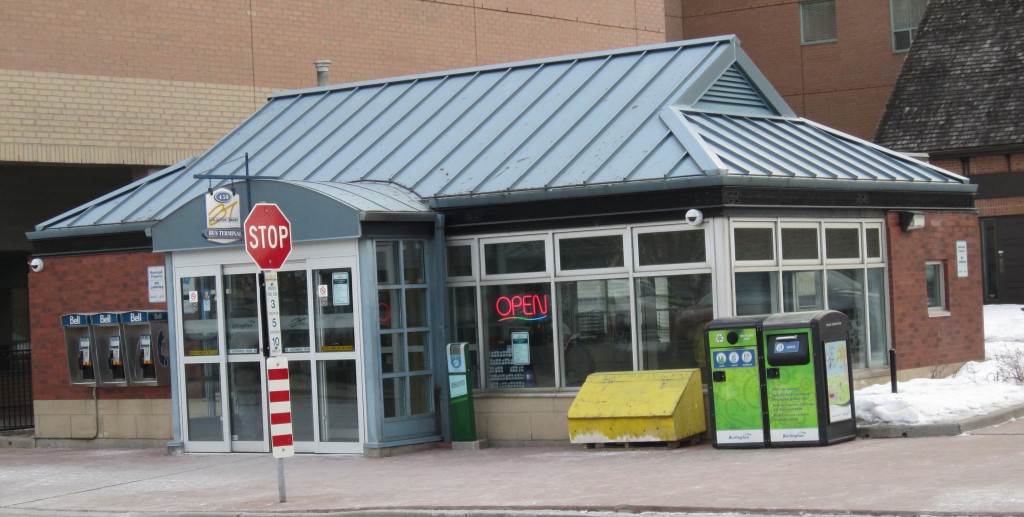 The suggestion that the John Street terminal be torn down to save $8000 a year in operating costs moved the discussion on transit and mobility hubs into new territory. We saw the thin edge of those discussions when Burlington Transit suggested closing the John Street terminal to save $8000 a year. That suggestion got turned down – the decision wasn’t unanimous.
The three discussions taking place are:
1: What are we going to do with public transit.
2: An overall Master Transportation Plan
3: The creation of Mobility hubs.
The John Street terminal became a budget issue; the transit people wanted to remove it while the recommendation in the draft Mobility Hub document said – “a strong transit presence was necessary for the downtown mobility hub.” The left hand didn’t seem to be talking to the right hand.
 The Big Move conversation was an important part of the province beginning to tackle the problem of moving people efficiently. The public review of the Mobility Hub concept for Burlington came about when the province, through Metrolinx, created a plan they called The Big Move. The province had come to the realization that better ways had to be found to move people. The congestion on the QEW was beyond being tolerable and traffic within the city was plugging up at major intersections frequently. Solutions were needed. The Big Move got the discussion started provincially now it is taking place in communities across the province. Because Burlington is in the process of reviewing its Official Plan moving people had to become part of that that conversation.
When the public consultation on the mobility hubs is complete a directions document will be sent to the team working up the next version of the city’s Official Plan, which is a document Burlington is required to review and revise every five years.
 The discussion was about four possible mobility hubs – one at each GO station and a fourth downtown. Mobility hubs are urban growth centers and major transit station areas with significant levels of planned transit service with high residential and employment development potential within an approximately 800 metre radius of the rapid transit station.
Hubs are seen as a gateway for visitors to a city. The objective of a hub is to create a seamless integration between modes: walking, cycling, transit and private vehicles with a mix of uses that support a healthy neighbourhood in attractive public spaces.
The need for these studies came about when Metrolinx, an agency of the Government of Ontario was created to improve the coordination and integration of all modes of transportation in the Greater Toronto and Hamilton Area. The organization’s mission is to champion, develop and implement an integrated transportation system for the region that enhances prosperity, sustainability and quality of life. Metrolinx launched The Big Move, a Regional Transportation Plan to allow people to use public transit to travel easily from Hamilton to Newmarket to Oshawa. It’s the final piece in a three-part approach by the province to prepare the Greater Toronto and Hamilton Area for growth and sustained prosperity.
Metrolinx is a part of the provincial plan that includes the Greenbelt, which protects more than 1.8 million acres of environmentally sensitive and agricultural land in the heart of the region, the Growth Plan for the Greater Golden Horseshoe, a plan that coordinates population and job growth.
The The Big Move – identified that the province’s transit and transportation problems as regional in nature and across municipal boundaries. The solution required the coordination and integration of transit and transportation systems in order to allow growth to happen and help people and businesses move more easily throughout the region.
In 2009, Metrolinx merged with GO Transit, the regional public transit service. The organization grew further with the addition of two more operating divisions – the Union Pearson Express in 2010 and PRESTO, an electronic fare card that allows riders to transfer seamlessly across multiple transit systems, in 2011.
Burlington is now applying Metrolinx Mobility Hub Guidelines, to identify and address opportunities and constraints of Burlington’s mobility hubs and major transit station areas. The thinking that comes out of the public meetings will inform the integration of mobility hub objectives and policy directions in the Official Plan and, where applicable, inform directions for the City of Burlington’s Core Commitment, Transportation Master Plan, Community Trails Strategy, Community Energy Plan, and others. Ideally, the community will propose Placemaking – streetscapes, branding, programming; Land Use – mix of uses, employment protection, infill; Built Form -height, massing, facades; Open Space and Circulation – transit, cycling facilities, new and improved parks.
The thinking for Burlington was four different mobility hubs: a downtown hub that would appear to center on John Street between John and Pine and then a hub at each of the GO stations: Burlington, Aldershot and Appleby Line.
We start this with a review of the thinking that has been done on the Downtown hub:
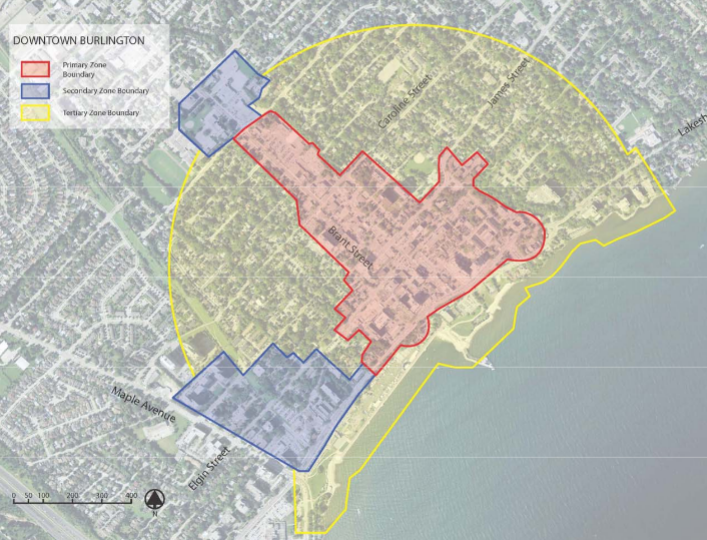 Boundaries set out for the Downtown mobility hub. For each situation the planners set out a mission statement and then provide comment on the opportunities and constraints with each situation; land use within a specific area (800 metres); and the existing built form.
Land Uses as set out in the draft document of a downtown hub would encourage mixed-use (retail, office, residential) infill with transit-supportive infrastructure on vacant and underutilized lots (Lots 4 and 5 subject to additional study).
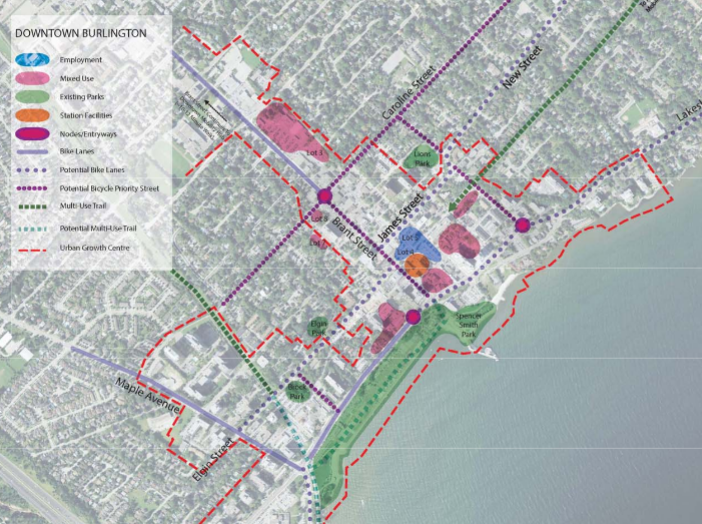 This graphic shows some of the constraints as well as the opportunities for a mobility hub in the downtown core. Along John and James Street, new development should reinforce a strong transit presence through attractive waiting areas, ticketing functions and supporting retail.
The idea would be to concentrate the greatest densities in close proximity to the transit station at John Street and along the key transit corridors to protect adjacent residential neighborhood’s and heritage buildings.
At the edge of the Primary Zone, the height, mass and design of buildings should be controlled to provide appropriate transitions to adjacent stable residential neighborhoods, Martha Street and Hurd Avenue.
Maintain and promote a transit presence at the Burlington Transit Terminal. Explore opportunities to redevelop the area as a mixed-use area, with transit – supportive uses at grade (i.e. cafes, plazas, retail, etc.) while retaining part of the site for complimentary transit facilities.
Develop Brant Plaza to ensure new buildings support the mobility hub vision, including pedestrian supportive streets and height limitations to adjacent properties.
The built for the downtown mobility hub would reinforce nodes at Baldwin Street/Victoria Avenue and Brant Street and on Lakeshore Road at the key Downtown intersections.
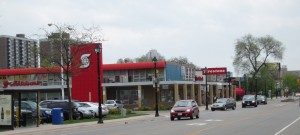 Would a downtown mobility hub result in greater density on the east side of Brant Street? Would traffic from the core work itself to the Burlington GO station? Where Tall buildings (> 10-storeys) are provided, typically on Brant Street/Lakeshore Road. they should be designed and massed to protect and frame views of Lake Ontario.
At Brant Plaza, new buildings should create a mid-rise (6 to 10-storey) character along Brant Street that compliments the uses south of Caroline Street. At the rear of the site, height limitations are encouraged to provide a transition to the residential dwellings along Wellington Avenue and Emerald Crescent.
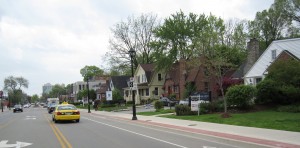 Would the west side of Brant Street south of the Brant Plaza be kept at a smaller scale? Would this create the kind of traffic that transit needs to justify the amount being spent on bus operations in the city. Does transit even have a future in Burlington? Mid-Rise and Tall buildings should be subject to front and rear-yard angular planes to reduce their perceived mass and minimize shadow and privacy impacts.
The report also asks that more efficient alternatives to surface parking, including above and below-ground structured parking where feasible, and on-street parking.
The Open Space and circulation thinking would Reinforce Brant Street as the primary Downtown main street leading to the waterfront. It should be a ‘complete street’ with equal consideration given to all modes of transportation, including transit, pedestrian, cyclists, and vehicles.
Promote Brant Street as the primary connection between the Burlington GO Mobility Hub and the waterfront. Support this role through streetscape initiatives, active ground floor uses and street-related infill that builds on the continuous pedestrian-supportive main street.
Promote pedestrian-focused street design on Brant Street and John Street to balance the multiple roles of the street as a vibrant place and connector.
Create a linked network of cycling connections to promote active transportation to and throughout the Downtown. New Bicycle Priority Streets are encouraged on local streets to provide continuous connections.
The draft document suggests extending the Centennial Bike Trail to connect to Brant Street as part of the Downtown Core Commitment.
As you read this over and look at the graphics – is this a Burlington you see in your mind’s eye; is this the direction you want to see the development of your city going in?
 Planners work from deep experiences bases but they need the thinking of the general public. While the public meetings on these hubs have come to a close there will be an additional opportunity for comment when the planners take their report to a city council Standing Committee, expected before the summer. There is never enough public input on projects like this in the early stages. Planners work from deep experiences bases but they need the thinking of the general public. While the public meetings on these hubs have come to a close there will be an additional opportunity for comment when the planners take their report to a city council Standing Committee, expected before the summer. There is never enough public input on projects like this in the early stages.
In the past Burlington has not had the kind of news media that provided this kind of background and explanation in context. Traditional print media rarely has the space to provide the illustrations.
The thinking behind the Burlington, Aldershot and Appleby GO stations follows in separate articles.
Background links:
John Street terminal not going anywhere right now.

 By Pepper Parr By Pepper Parr
March 11, 2014
BURLINGTON, ON.
James Burchill, a totally shameless self-promoter, has built the Burlington Social Fusion Network to 1500 people and is currently developing an additional nine – read that again, nine social networks elsewhere in the province.
Later this month – March 20th to be exact, Burchill will be holding his third mini-trade mart at the Performing Arts Centre.
Burchill doesn’t charge a dime for any of his events. There is a fee if you want to exhibit at his events – but getting in the door is free, free, free.
He will try to convince you that a typical Chamber or Rotary networking group typically costs about $1 a day or $365 a year. It’s not uncommon for people to join multiple groups so it would be pretty easy to spend $1000 a year on networking memberships.
 Quite a business card isn’t it? James Burchill, the guiding force and the energy behind the Burlington Social Fusion Network is all business. “At the SFN we don’t charge money for membership … and believe me when I get a whiny email from someone about “too many emails” I shake my head and think maybe I should reconsider charging!
He goes on to suggest: “For instance, if I charged each Burlington member just $25 per person per month for membership, I’d be banking MORE THAN HALF A MILLION DOLLARS … A YEAR! And with 9 other chapters growing steadily that would be some serious money.”
“But that’s NOT why I built the network. Charging money changes the dynamic. It stifles growth and makes people treat the experience differently. It would be a short term gain for me but in the long run the network would eventual suffer the fate many “old school” networks are experiencing today. Dwindling memberships, falling revenues, lack of engagement and more. Technology has changed how we connect and network and SFN reflects that.
“So I’m not going to change the SFN model … but please remember this: The Social Fusion Network is not a charity, it operates as a business and therefore needs to cover costs and other expenses. That’s why we license the networks to smart businesses who see the marketing value of the platform and we also offer advertising … which is why occasionally you’ll get more emails.
 It’s all about networking. “Business is about promotion, connection and communication. More is better. Less is not. That’s my opinion and I know not everyone agrees, which is why I said you have choices. However I hope you’ll stay a member because I believe in the model as do thousands of other local businesses.
People do attend. It is not uncommon to see someone pull up in front of the Ivey Bar and Kitchen and wiggle out of a pair of jeans in the front seat of their vehicle, wiggle into a shirt, fluff their hair and walk briskly into a room full of people they can network with – some they know, others they expect to get to know. The SFN events are not a dating pool – this is business. If you’ve not been – give it a try.
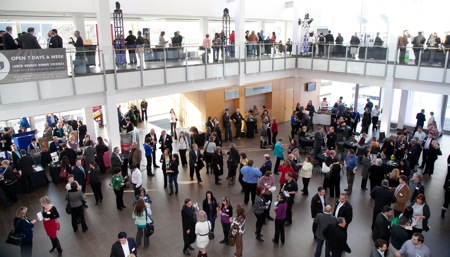 The Social Fusion Network trade show always draws a good crowd. It’s small but it is busy and clients keep returning – so something must be happening. Back to that trade show: 517 people have registered for that Burchill calls his Business Networking and Trade Show.
Burchill has this ability to make everyone he works with feel important – because for him they are important. Graham Frampton, the Performing Arts Centre Operations Manager quickly became a critical part of the team that makes the trade show work.
Watching Burchill work with Frampton, who is his service supplier, is a lesson in customer relationship development – except in this case Burchill is the customer who goes out of his way to make Frampton’s job easy and as a result gets great service. Burchill has lessons for all of us.
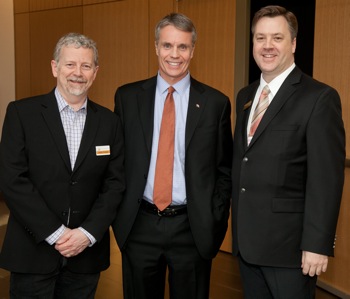 If you want people to be part of your team – make them feel like they are part of your team. James Burchill, on the right, drafted Mayor Goldring, centre and Performing Arts centre Operations manager Graham Frampton as part of his team. It worked very well. Burchill wanted to add some zip to his event and gave the Mayor a call: The Mayor responded, showed up and – well let Burchill tell that story. “Mayor Rick Goldring graciously delivered the opening remarks. I was thrilled when The Mayor publicly acknowledged our networking efforts and what they’ve done for local business. Very gratifying indeed.”
The enthusiasm is all part of what Burchill does. What you see is what you get. “I have to say,” says Burchill, “it’s been a real thrill producing this event. When I started this project it was nothing more than a fleeting idea. It took shape and with some hard work (ok … lots of hard work!) and a little bit of luck, it all worked out in the end.”
March 20th – 5:30 at the Performing Arts Centre. Look for James – he might be wearing a bright orange vest and matching bow tie someone gave him – I can’t believe for a second that he bought it.

 By Staff By Staff
March 10, 2014
BURLINGTON, ON
Burlington Community Foundation (BCF) announced today that is has awarded 25 grants to a wide array of charitable organizations serving Burlington. A total of $90,615 in grants was distributed.
These grants are a result of a Call for Applications that was distributed to local charitable partners in October. The Call followed the release of BCF’s Vital Signs® community check-up report on October 1, 2013. This report, which shared many of Burlington’s successes in employment levels, living standards, and public safety, also highlights the sometimes unseen concerns, including residents living in poverty, and challenges facing both youth and seniors, especially regarding mental health. The complete report can be viewed on-line at burlingtonfoundation.org/vital-signs.
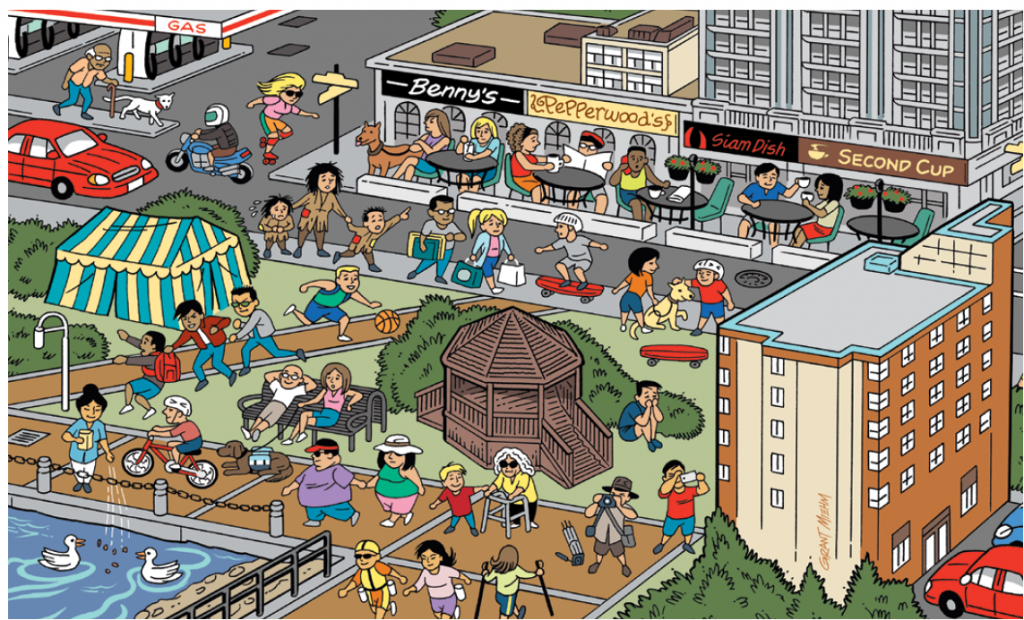 The Community Foundation’s Vital signs report identifies some of the problems Burlington strives to deal with; the Grant program provides funds to resolve some of the problems. “Our 2013 Vital Signs Report reminds us of all we have to be proud of in Burlington, and the many reasons that we call this wonderful city home,” said Colleen Mulholland, President & CEO, Burlington Community Foundation. “At the same time, the report again brings into focus that people, including children and seniors, are living on the boundaries and are truly struggling every day to meet basic needs.”
One of the organizations receiving funding is Acclaim Health, with a grant in support of a Music Care Program for Seniors with Dementia. Melissa Cameron, Acclaim’s Director, Development and Marketing, comments: “Your investment will allow us to engage a music therapist and train our staff, ensuring your grant will have a long-lasting impact on seniors with dementia in our community. We sincerely appreciate your support.”
“I was greeted with wonderful news this morning – a grant confirmation from the Burlington Community Foundation. The ArtHouse application is an indication of the need to provide cost-free arts programs to Burlington families that have little or no discretionary funds to access paid programs. Your support means so much for these wonderful young artists, who could not otherwise participate,” says Don Pangman, Founder and Artistic Director, ArtHouse.
2014-15 Grant Applications will be received in the fall of this year. Charities are encouraged to visit the website at burlingtonfoundation.org/grant-seekers to learn more about the grants process, or they may contact Sandra Baker, Director, Development and Community Engagement at sbaker@burlingtonfoundation.org to learn more.
Organizations and amount of the grant given:
Acclaim Health Music Care Program for Seniors with Dementia 3,000
ArtHouse Weekly after school programs for children in at-risk neighbourhoods, with a focus on arts. 2,000
Bay Area Restoration Council Education and Restoration of Cootes Paradise Marsh 2,500
Bruce Trail Conservancy Cedar Springs Woods Land Management Plan 2,545
Burlington Central FIRST Robotics Program Students work with teachers outside school hours to create a robot suitable for a competition taking place in April 2014. 5,000
Burlington Teen Tour Band Boosters Angel Fund: A pool of funds that provides subsidy for lower-income band members. 2,370
Central West Specialized Developmental Services – Halton Support Services Halton Sibshops: Siblings of children with developmental issues receive support and education in a positive environment. 2,000
Easter Seals Ontario Kids to Camp–Healthy Minds, Happy Kids 2,000
Food for Life and BurlingtonGreen Grow To Give: A collaborative project where volunteers learn and practice gardening life skills and share harvested food with those in need in Burlington. 3,531
Food4Kids Hamilton Halton Niagara Backpacks are filled with healthy food for at-risk, low income children who would have little to no food over the weekend. 4,000
Joseph Brant Hospital Foundation Expansion of the Mental Health Services – Childhood and Adolescent Program 4,000
King’s Road Public School (Halton Learning Foundation) Connecting Kids to Music: Provides a guitar for grade six students to play and perform. 4,000
Nelson Youth Centres Therapeutic Summer Program: 8 week program for children with moderate social and emotional issues. 4,000
Plains Road Village Vision/Aldershot BIA Public Art Project: The group intends to purchase a piece of public art for a busy Aldershot intersection. 1,844
ROCK – Reach Out Centre for Kids Our Community Cares Healthy Living Project: An ongoing after School and summer camp program for at-risk children and youth. 7,000
Rolling Meadows Public School (Halton Learning Foundation) Skateboarding & Re-engagement: A re-engagement tool for grade eight students with severe behaviour issues. 1,565
Royal Botanical Gardens Green Angels Program: A pool of funds made available to schools participating in RBG environmental school programs. 2,500
Sports4You (YMCA) Free, weekly recreation program for 10-12 year olds in the lower-income area of Warwick-Surrey. All children are welcome. 8,800
St. Christopher’s Church Open Doors Outreach Program, Community Kitchen and Meal Network 4,960
STRIDE – Supported Training and Rehabilitation in Diverse Environments Helping Youth Prepare for Employment: Addresses the needs of youth age 16 to 24 who have mental health and addiction issues. 7,500
Support & Housing Halton Growing your Life Skills Workshop: Workshop series promotes independence for people living with mental health challenges. 2,500
The Equestrian Association for the Disabled Trot On! Equestrian activities enhancing mental health outcomes for children and youth with developmental and physical disabilities. 3,000
Tottering Biped Theatre To create a theatre piece that explores themes of isolation and loss among youth in the digital age. 3,500
United Way of Greater Hamilton Burlington and ADAPT Halton Know the DEAL: Provides information and support regarding substance abuse. 4,000
YMCA of Hamilton/Burlington/Brantford Beyond the Bell – Home Library Project: An academic after school program for lower-income children. 2,500
Background links:
Masquerade Ball – Major Community Foundation fund-raiser.
Vital Signs: the city’s social health.

 By Staff By Staff
March 10, 2014
BURLINGTON, ON.
On Saturday March 8th 2014, a salesman working for National Home Services was going door to door in the area of Riverside Drive in Burlington, trying to get residents to switch their hot water tank services.
At about 12:30 pm, the salesman was invited into a residence where he talked to the female homeowner. After some discussion, the homeowner decided not to switch services and the salesman left.
Shortly after, the female homeowner and one of two her children departed the residence to do errands, leaving her 11-year-old daughter alone in the home.
Just after her mother left the residence, the 11-year-old heard someone knocking on the door and as she went to answer it, she noticed the door was opening so she went upstairs to retrieve a phone.
As she returned downstairs, the same salesman approached the 11-year-old child on a landing where he asked if her parents were home, her name and how old she was. After she answered the questions, the salesman placed one hand on the girl’s shoulder and another over her mouth then told her not to scream and he wouldn’t hurt her. When the salesman removed his hand from her mouth, she seized an opportunity to escape and ran unharmed from the home to a neighbour where police were called.
The salesman fled the residence but was quickly arrested by police a short distance away and held for bail.
Arrested:
Daniel WIGHT (19 yrs.) of Birchmount Rd. in Toronto
Charges:
- Break, enter and commit assault
- Forcible confinement
- Uttering threats
Anyone with information on this or any other crime is asked to call Crime Stoppers at 1 800 222-8477 (TIPS) or through the web at www.haltoncrimestoppers.com or by texting “Tip201” with your message to 274637 (crimes).

 By Staff By Staff
March 9, 2013
BURLINGTON, ON.
Cute name, conveys the message, and it might meet the needs of busy people with significant parent and child care responsibilities.
Imagine That offers a service that includes back-up care when there is a temporary disruptions in child, adult, or elder care that prevents them from fulfilling work obligations.
The reality of bustling city life: the commute, the traffic, the long work day of meetings and juggling multiple projects, the cell phone calls, emails, texts, and then of course family needs are thrown into the mix. Finding time for everything is a challenge, especially for those who have children, or are in need of adult or elder care.
Imagine That, originally a child care services operation, has expanded to offer back up care for individuals of all ages – children, adults and seniors, under the umbrella of Imagine That Family Care Services.
The services, a first of its kind, means employers can now set up Imagine That Corporate Family Backup Care for their employees.
 Managing that work life balance usually requires involving outsiders – where do you find the people who you can trust – and afford? “Our services offer employers and employees alike with that added piece of mind. Through the support of our professionally trained staff, employees now have the opportunity to utilize back-up care services like no other so that they can meet necessary work commitments.”
Anne Bonfigli, Director Sales & Marketing for Imagine That Family Care Services, explains it this way: our extensive services for family care are about supporting employees while helping keep work absenteeism to a minimum”.
“People out there want to excel in their careers and now have access to a support system that covers employees from all walks of life –from the trades and labour, to professionals, and all the way to Bay Street.”
The family care services are cost-effective and flexible and they are offered round the clock, 365 days per year.
Imagine That Family Care is a division of Bartimaeus Inc. Bartimaeus was founded in 1988. It is a Canadian-owned and operated company, committed to providing the highest quality services to individuals of all ages. The services of Imagine That were first offered in 2001. The expansion into Imagine That Family Care Services is a result of the company’s dedication to the highest quality of services that are safe, engaging, and professional.
Imagine That Family Care provides high quality child care, adult care and elder care to individuals, families and employers in Toronto and the Greater Toronto Area. Their Corporate Family Backup Care service is made available to employees, through their employer, often incorporated into their wellness programs. Their Hotel Family Care service is available to guests staying at premium Toronto hotels, whether they are visiting for leisure or business, and need a quality care for their child or senior who may be travelling with them. The Direct Family Care service is available to family members of all ages. The care providers arrive to an individual’s home, prepared with age-appropriate activities.

 By Emily Ferguson By Emily Ferguson
March 8, 2014
BURLINGTON, ON.
My name is Emily Ferguson and I am the sole individual behind Line 9 Communities. (This is a blog Ferguson writes about the communities along the path of the Enbridge Pipe Line 9 that runs from Sarnia to Montreal.)
I graduated from McMaster University with Honours BA Geography & Environmental Studies and a minor in Political Science.
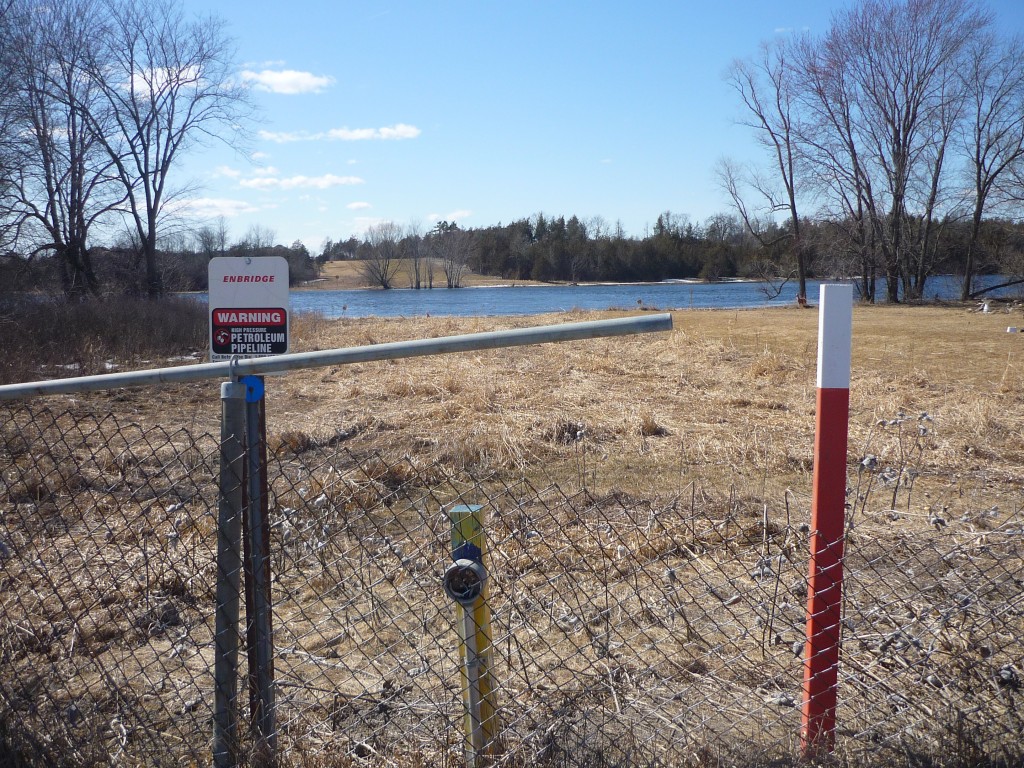 Emily Ferguson mapped every yard of the pipeline so that communities along its path could know just what was beneath the ground. I first heard about Line 9 at a climate conference in Ottawa in 2012. My interest led me to attend information sessions in Hamilton and surrounding area in early 2013. At one meeting in particular, I asked for a Line 9 information package which had been provided to Council. Although there were extra packages after the meeting, an Enbridge official denied my request and asked “Who are you working for”? The Enbridge team then proceeded to ask myself and a fellow community member for our driver’s licenses and said they would mail a package. Something about the encounter just didn’t feel right and we walked away without the information.
 Emily Ferguson – National Energy Board intervener, geographer. That was the turning point. I went home that night with so many questions. Why was I being denied access to information at a public meeting? What were they trying to hide? Why didn’t they want me to know where the pipeline was?
So I took it upon myself to map Line 9. Throughout an unimaginable number of late nights, I compiled satellite images, integrity data and publicly available information to create detailed maps of the 639 km pipeline.
I did it because they said no.
I did it because I felt the need to inform the public.
If Enbridge wasn’t going to adequately consult … who would?
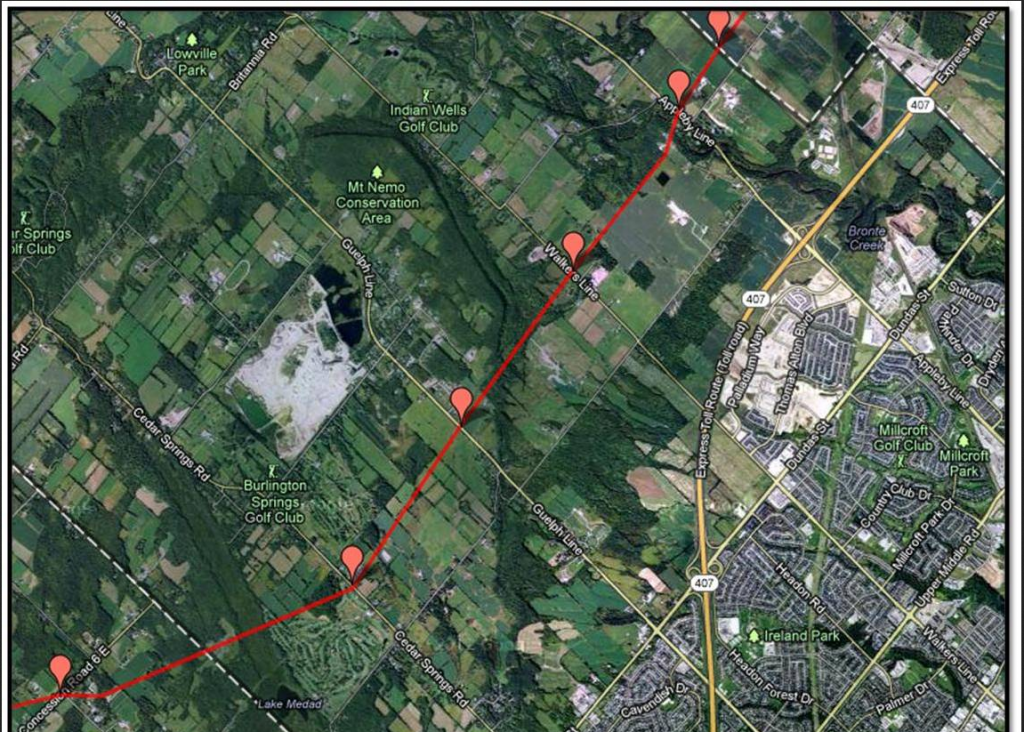 For Burlington – this is where the pipeline was located. I contacted multiple City Counselors along the line and sat down over coffee with many to discuss the proposal. The lack of information provided to municipalities shocked me. I proceeded to canvass neighbourhoods along the line to poll residents and provide details about open houses and how to get involved.
Line 9 Communities gained instant attraction. Although I blogged about the application, past spills, and changes to federal legislation, viewers wanted one thing … MAPS! Essentially they wanted to know, where is the pipeline and why don’t I know about it?
 Emily Ferguson mapped ever foot of the pipeline from Hamilton to Montreal and learned that the thing ran underground right behind her elementary school – the pipeline had always been a part of her life – She didn’t even know it was there. During the map creation, I found out that Line 9 crosses right through the small community where I grew up. The pipeline is located directly behind my public school playground in Glenburnie, ON, just north of Kingston. It also passes behind Seneca College in Toronto which I attended for three years. I had literally been living beside the line my entire life … and didn’t even know it existed. All of a sudden, things became very personal.
I felt compelled to learn everything I could about the project. My biggest supporter along the way was Eva Simkins – my Grandma. Although diagnosed with cancer in 2009, two weeks of radiation treatments gave us the gift of four extremely memorable years. We traveled, talked politics, did puzzles, celebrated, smiled and laughed. Through it all though, I knew there was that big question in her mind. Why me?
I wondered the same thing.
She held my hand as she peacefully passed away at sunrise on Earth Day of this year … just three days after I applied to be an NEB Intervener.
In my opinion, we accept the status quo far too often. At a Line 9 open house, an Enbridge official told me, “if we say it’s safe, it’s safe”. But I must question the safety of this pipeline. At almost 40 years old and only meeting the engineering standards of 1971, why is the NEB even considering the application? Enbridge has cited over 400 integrity digs (cracks, corrosion, dents) along the line in 2013 alone! They have also acknowledged that their in-line inspection tools do not detect all defects and that their Edmonton control center cannot sense pin hole leaks. With the current application before the Board, Enbridge is proposing to ship Bakken crude and diluted bitumen laced with drag reducing agent (DRA) chemicals – which include known carcinogens such as benzene – through our communities.
I have never had any malicious intent towards Enbridge. As a citizen of Canada and student of environmental politics, I have always been interested in energy issues, climate change, and a sustainable future for our planet. I believe in the strength of communities working together to achieve great things.
My mission through this entire process has been to raise awareness and promote a community discussion. We are living in a critical time. Will we continue to accept the status quo, or will we start asking the tough questions and demand a better future?
Editor’s note: I had an opportunity to interview Emily while she was thinking about applying to be an intervener at the National energy Board hearing. She wasn’t sure what she was going to do then and she needed quite a bit of encouragement to send in her application, which was an experience in itself. But on October 16th, 2013, Emily Ferguson, all 5’ 2” of her stood before one of the most powerful regulators in the country and gave “the best speech of my life”
Background links:
Burlington doesn’t take to the idea of a change in the flow of the Enbridge pipeline
National Energy Board give Enbridge a green light – with 30 conditions.
The Emily Ferguson maps.

 By Pepper Parr By Pepper Parr
March 7, 2014
BURLINGTON, ON.
It’s just, jobs, jobs, jobs – nothing else matters. The focus on creating jobs is so tight that Progressive Conservative leader Tim Hudak has decided to move off his “right to work” position, which no one other than the hard headed right wingers who didn’t like the increase in the minimum wage, liked all that much anyway.
The province released data on Friday – Ontario gained 6,100 net jobs in February – full-time employment rose by 5,300 positions last month. Ontario’s job market grew by 95,700 net jobs in 2013 and today’s increase is in addition to the 6,000 net jobs the province gained in January.
 Premier Wynne runs a job training course for Mayor and Ed Eves, president of the Lakeshore Rotary Club The province has recovered all the jobs lost during the global recession and employment is now 2.7 per cent above the pre-recession peak. February’s job gains contributed to an overall increase of 446,100 jobs since the low point of the recession in June 2009. Ontario’s economic recovery continues to outpace the United States and the Great Lakes States since June 2009.
In February alone, Ontario announced investments that will help create 340 new jobs and retain almost 2,300 jobs in the province.
The provincial government claims it is creating 200 manufacturing and R&D jobs by supporting the launch of a new clean energy manufacturing facility in London.
 Cisco is investing heavily in the Toronto area market and expects to invest $100 million over ten years. Toronto has been selected as the location for one of four global Cisco Internet of Everything Innovation Centers, representing an investment of $100 million over 10 years. The province is taking some of the credit for this development.
Ontario has committed over $100 million through Southwestern and Eastern Ontario Development Funds — attracting a total investment of almost $1 billion. This is helping to create and retain more than 24,400 jobs in Ontario communities.
We didn’t see any of that money landing in Burlington
The province has a Youth Jobs Strategy that they claim will help create job opportunities for about 30,000 youth over two years. It has already created internships and job placements for more than 8,200 youth in the province.

 By Pepper Parr By Pepper Parr
March 7, 2014
BURLINGTON, ON.
That the National Energy Board (NEB) decided to let Enbridge Pipeline Inc., reverse Line 9, a pipeline that runs right through the top of Burlington, should not have been a surprise. We are talking about oil from Alberta that they want to transport to Montreal and nothing was going to stop that from happening.
That it is some of the dirtiest oil being taken out of the ground was not a concern; that we spend a tremendous amount of energy getting that oil out of the ground was not a concern either.
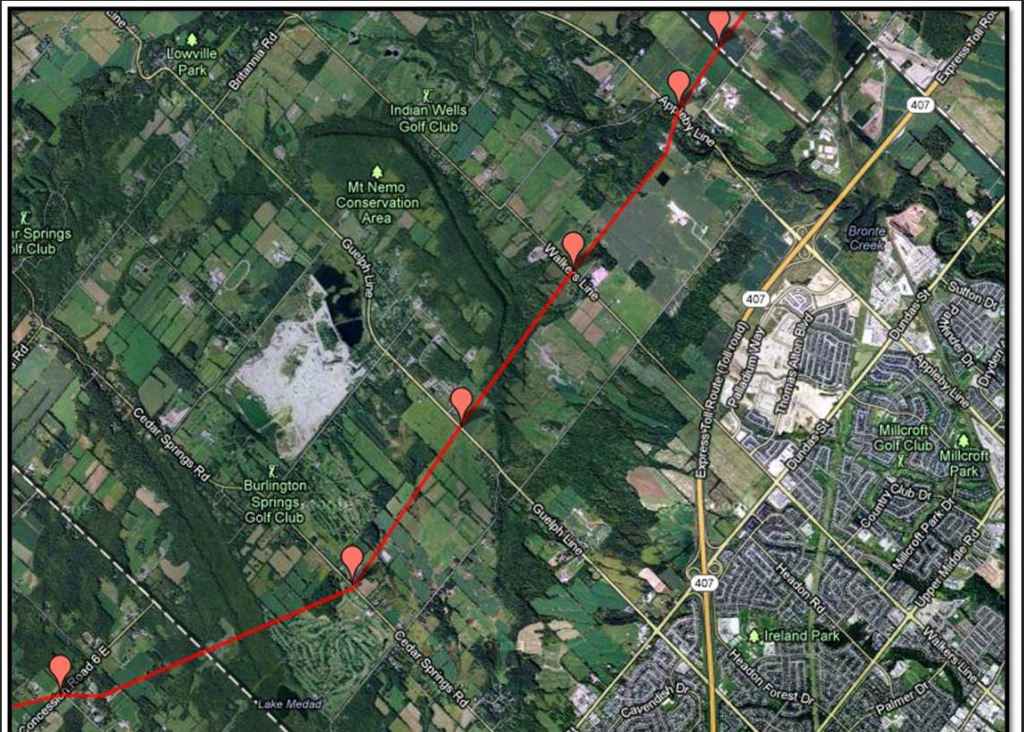 Enbridge has an 18 metre easement through the top of the city. A serious break or leak in that line puts toxic bitumen into parts of the city’s water supply. That the pipe line is close to 40 years old and has had numerous problems – well that was a concern and the NEB did put 30 conditions into their decision – which was a first step. Ensuring that Enbridge complies with those conditions is like expecting a drug addict to live up to bail conditions – doesn’t happen.
Enbridge is not a nice company; they tend to bully and they have real clout with the federal government and its regulators and they aren’t shy about using that clout. They aren’t comfortable with the truth and they think their technology can solve every problem that crops up. They fail to realize they are working against nature – not a win situation for them.
Having said all that – that oil is going to flow and it is going to flow through our back yard and we had better ensure that we have the resources in place to handle any break or leak in that line. And we need to hold Enbridge accountable and give up on the idea that they are a responsible corporate entity that will do the right thing. There is far too much evidence saying they won’t and they don’t.
In its media release the city says “it’s encouraging that the National Energy Board has placed conditions on Enbridge Inc. before Enbridge can reverse the flow of its Line 9B pipeline through Burlington and other municipalities.”
That’s a generous interpretation.
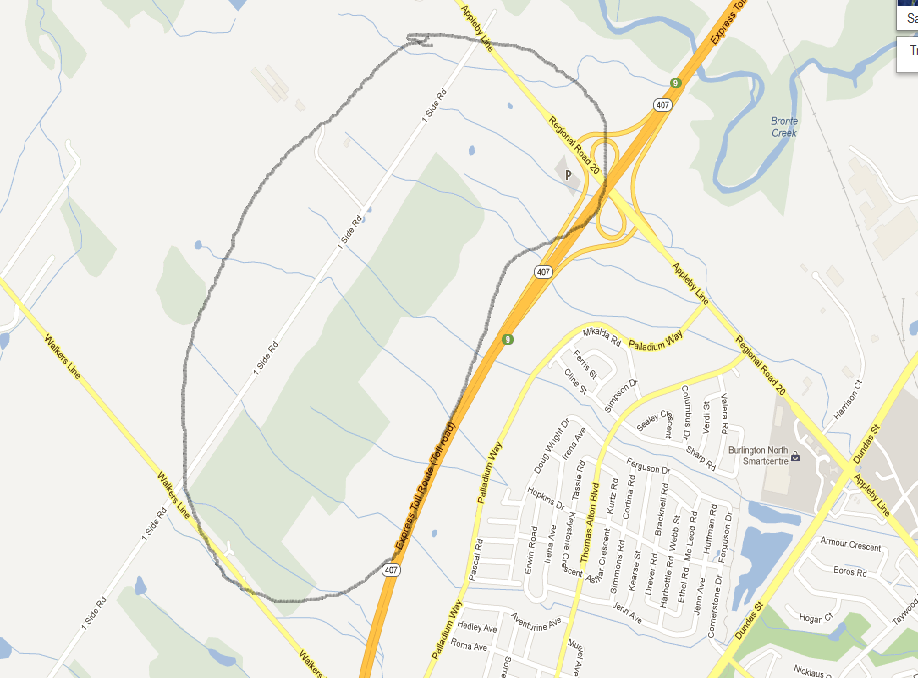 These are the creeks that run from the Escarpment towards Lake Ontario. We all know where they are in the city – we just want them to continue to carry clean water to the lake. “There are 30 conditions Enbridge must meet, including concerns identified by the City of Burlington in July 2013,” said Mayor Rick Goldring who was “cautiously optimistic” and believes “the National Energy Board took the city’s considerations to heart, which is encouraging. The safety of residents and the environment cannot be treated lightly.”
Time is needed to do a closer read of those 30 conditions. While you and I are reading those conditions Enbridge will be reading them and looking for ways to handle them at the least cost.
In its application, Enbridge requested NEB approval to reverse the direction of flow on a 639-kilometre segment of pipeline between North Westover, Ont. and Montreal, Que., as well as approval to increase the overall capacity to 300,000 from 240,000 barrels a day of the Line 9 pipeline from Sarnia to Montreal.
When the city sent a letter the NEB in July 2013 asking that Enbridge’s overall approach should minimize the likelihood of a release and that Enbridge should lead an effective and coordinated response in the event of a release; and that Enbridge should be fully accountable financially and operationally if there is a release.
Why does the city use the word “release” – it will be a leak from an old pipeline that was not properly inspected and not effectively maintained. Time for the city to call a spade a spade and get away from that silky smooth language of the public relations experts.
When there is an oil leak – we want Enbridge to be the first to know and then have them call the first responders in Burlington within in minutes.
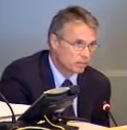 Mayor Rick Goldring: He does a pro-active mode and when he’s confident he puts it to good use. Time to get confident on this one Your Worship. Mayor Goldring got into his pro-active mode and invited Enbridge to provide the community with an overview of the project back in February of 2013. Showing us more of that pro-activity would be healthy for our Mayor
Line 9 runs through Halton Region in an east-west direction north of Highway 407 and south of Lower Base Line Road. In Burlington, the pipeline is located in an 18.3 metre easement north of Number 1 Side Road. There are no municipal approvals or permits required by Enbridge for this project.
“In its decision, the National Energy Board has imposed conditions on Enbridge, including pipeline integrity, focus on emergency response, and continued consultation, all of which are important for Burlington,” said Scott Stewart, general manager of development and infrastructure with the city. “The NEB also refers to Enbridge’s need to have ongoing emergency response planning and consultation with municipalities and first responders. I think there is a level of detail in the NEB decision that we can work with.”
Stewart has taken a course in learning how to whistle as you walk past a graveyard.
The city is reviewing the 141-page decision and will be conferring with its municipal partners to determine the implications. The city will work with the municipal liaison group—which includes Hamilton, Mississauga and Toronto—and Enbridge to address conditions related to coordinated emergency response, pipeline integrity, lifecycle management, watercourse crossing management and post-construction monitoring.
Staff on the Burlington Fire Department receive regular training from Enbridge to be ready to respond should a spill take place.
BurlingtonGreen isn’t quite as positive as the city appears to be. They are “disappointed with the announcement of conditional approval of Enbridge’s Line 9 pipeline proposal.”
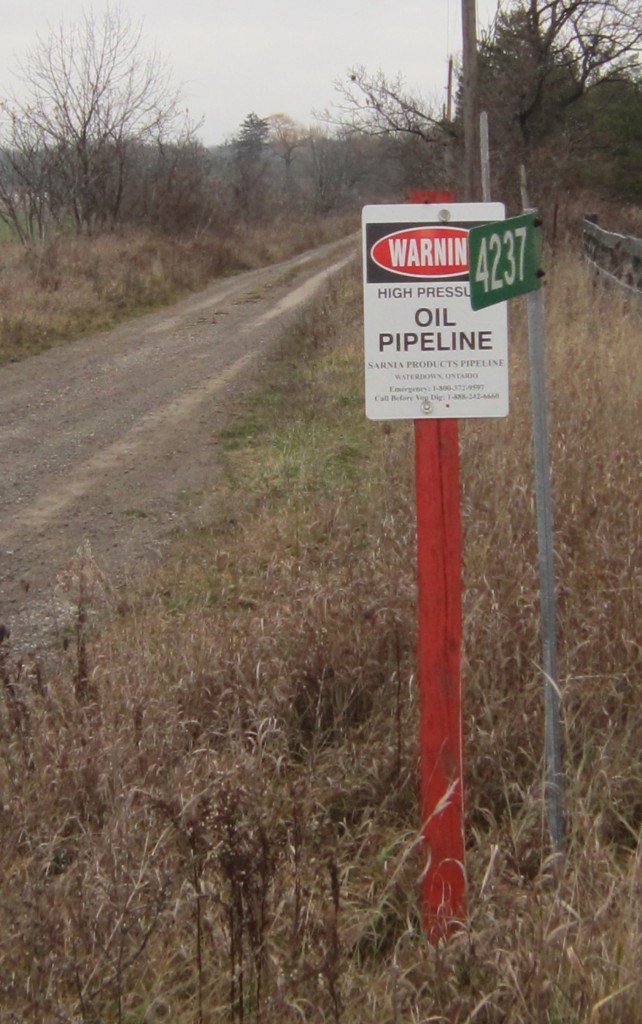 Will this landowner be involved in discussions about what gets done if there is a spill? BurlingtonGreen “remains concerned not knowing if the public will have a chance to review the plans to mitigate risk to the drinking water of millions of people across Ontario and Quebec” and they want to know what will be done to protect the significant environmentally sensitive areas it crosses including the crest of the Niagara Escarpment in Burlington that has several species at risk. How, they ask is Enbridge going to engage local right of way landowners and neighbours, local governments, as well as train first responders. In addition, the position of shut off valves across water courses remains unspecific.
Thousands of citizens have signed petitions asking for full Provincial environmental assessments. Letters have been written to Provincial and Federal Ministers; people participated in public rallies, agencies formed coalitions, media were engaged, and the message was brought door to door in several awareness campaigns to residents in dense urban communities across the GTA and around Lake Ontario communities that did not realize the pipeline literally travels underneath them.
BurlingtonGreen with others brought the issue to the attention of the Burlington Mayor and City Hall in several delegations asking them to become involved to protect Burlington’s Niagara Escarpment and watershed system that feeds to Lake Ontario and Burlington resident’s drinking water, which they indeed did. For that Burlington residents may be grateful to a proactive local government. Unfortunately the National Energy Board is a federal regulator, so this has been another experience of local government hitting the jurisdictional authority wall and having little power to do more than issue statements of concern. That said, significant municipal collaboration did occur as the staff of towns and cities across the GTAH worked together to prepare collectively as interveners for the NEB hearing.
Background links:
Burlington not very interested in Enbridge’s plans for changes to the pipeline.
Enbridge passes a cheque along to the city, was it a sin tax?
Emily Ferguson; a community activist who spoke for the public at the NEB hearings.

 By Staff By Staff
March 7, 2014
BURLINGTON, ON.
A company engaged in garbage removal and hauling, and a supervisor have been found guilty of failing to ensure the safety of a worker who fell off a roof. The company was fined $75,000 and the supervisor has been sentenced to 45 days in jail. A company representative has also been fined $2,000 for obstructing a Ministry of Labour investigation.
The incidence took place in October of 2008, when workers were sent to an address to remove shingles from a one-storey bungalow. One of the workers was tossing loose shingles from the roof toward a bin and stepped back, then slipped. The worker rolled off the roof of the house and landed on a walkway. The injury resulted in permanent paralysis of the lower body. A Ministry of Labour investigation followed the incident.
 No safety harness for these workers. You can get sent to jail for that in Ontario. The injured worker testified to not being trained in the use of fall protection equipment, nor was any such equipment provided in the company-supplied truck used for transportation to and from the job site. As well, the worker indicated that the practice for payment for work was cash and that work was provided on an on-call basis. The worker identified J.R. Contracting Property Services as the employer and Teisha (Tina) Lootawan as the supervisor.
The court determined that the worker was an employee under the definition of the Occupational Health and Safety Act (OHSA), and that J.R. Contracting Property Services was the employer. The court also determined that Lootawan was a supervisor under the OHSA. As such, she failed as a supervisor to ensure that a worker wore protective devices as required by law, and failed as a supervisor to take the reasonable precaution of ensuring that an adequate form of fall protection was provided where a worker is exposed to a fall hazard of more than three metres.
As the Ministry of Labour investigation proceeded, the company was requested to provide documentation that included employment and telephone records. A company representative, Andrew Joshua Haniff – who accepted the call from the Meadowvale Road homeowner requesting the company’s services – attended a meeting on December 23, 2008, but refused to answer any of the inspector’s questions. He was convicted by the court of obstructing an inspector.
The jail sentence and fines were imposed by Justice of the Peace Mary A. Ross Hendriks. The court heard seven days of testimony over 2011 and 2012; judgment was passed April 18, 2013.
The investigation, the court case and the decision point to the responsibility corporations and their senior staff have for the safety of their workers.

|
|
 In the Parish Hall 1382 Ontario Street, on Saturday April 5 with continuous servings of the best spaghetti & meat balls in town from 5:00pm to 7:00pm.
In the Parish Hall 1382 Ontario Street, on Saturday April 5 with continuous servings of the best spaghetti & meat balls in town from 5:00pm to 7:00pm.




















 The city recently released a report, it was put together by Andrea Holland of the Clerks department and covers almost every sin imaginable when it comes to what information there is, what you can have, what you can’t have and how you get it. It’s not exactly an easy read but the information is there.
The city recently released a report, it was put together by Andrea Holland of the Clerks department and covers almost every sin imaginable when it comes to what information there is, what you can have, what you can’t have and how you get it. It’s not exactly an easy read but the information is there. The guide was prepared in consultation with staff and members of council to ensure that the information provided was clear and informative. Further research was conducted on Information and Privacy Commission orders that have been issued with respect to councilor records as well discussions with staff from the Ministry of Government Services.
The guide was prepared in consultation with staff and members of council to ensure that the information provided was clear and informative. Further research was conducted on Information and Privacy Commission orders that have been issued with respect to councilor records as well discussions with staff from the Ministry of Government Services. Constituency records:
Constituency records: Email:
Email: If an elected official wishes to retain a copy of any records associated with their time in office, contact the City Clerk.
If an elected official wishes to retain a copy of any records associated with their time in office, contact the City Clerk. Examples of mayoral duty records, which may be accessible:
Examples of mayoral duty records, which may be accessible:

 To position it to that era, I included a 1957 Chevrolet Bel Air
To position it to that era, I included a 1957 Chevrolet Bel Air


































 Planners work from deep experiences bases but they need the thinking of the general public.
Planners work from deep experiences bases but they need the thinking of the general public.
























